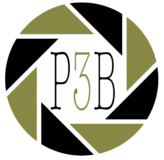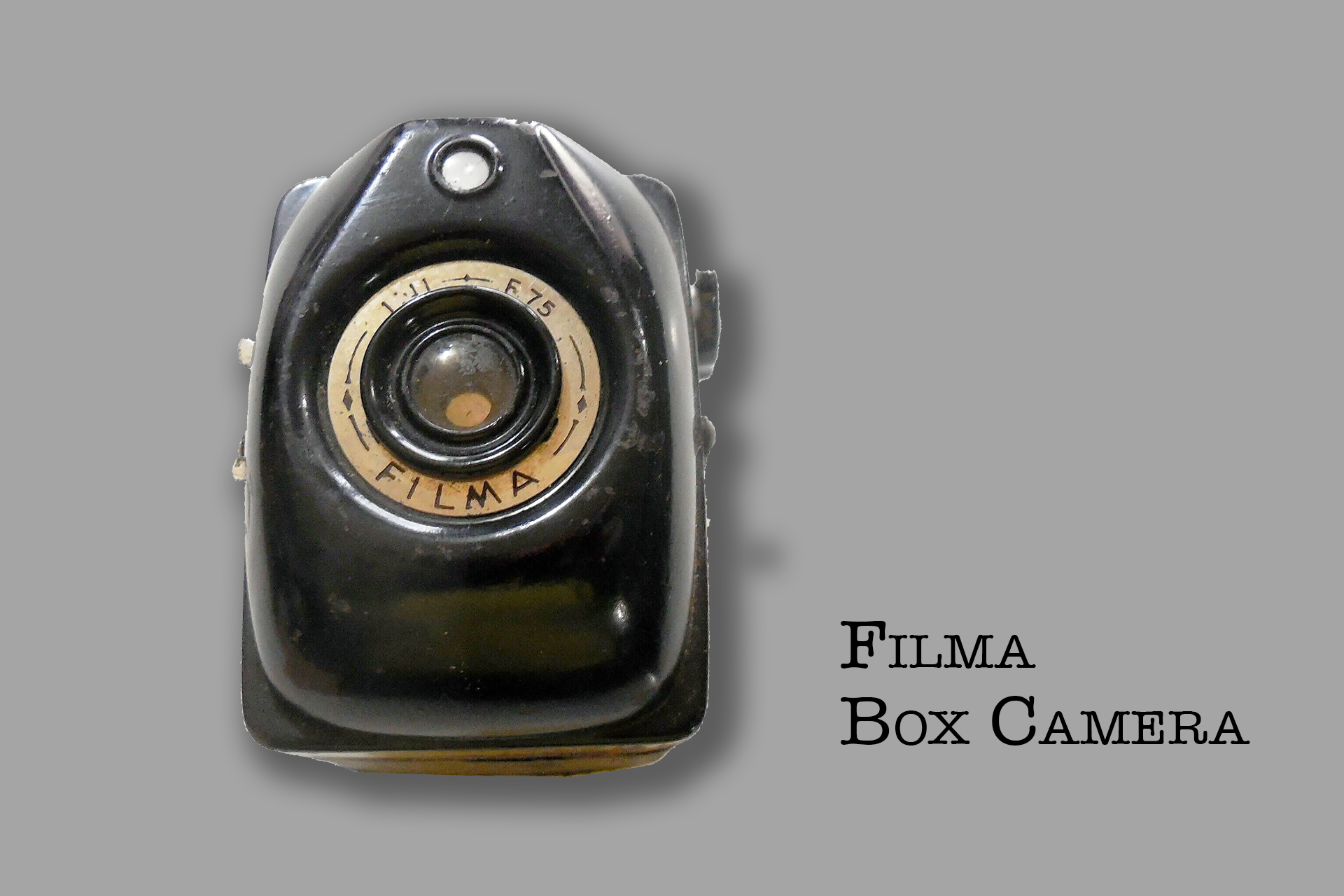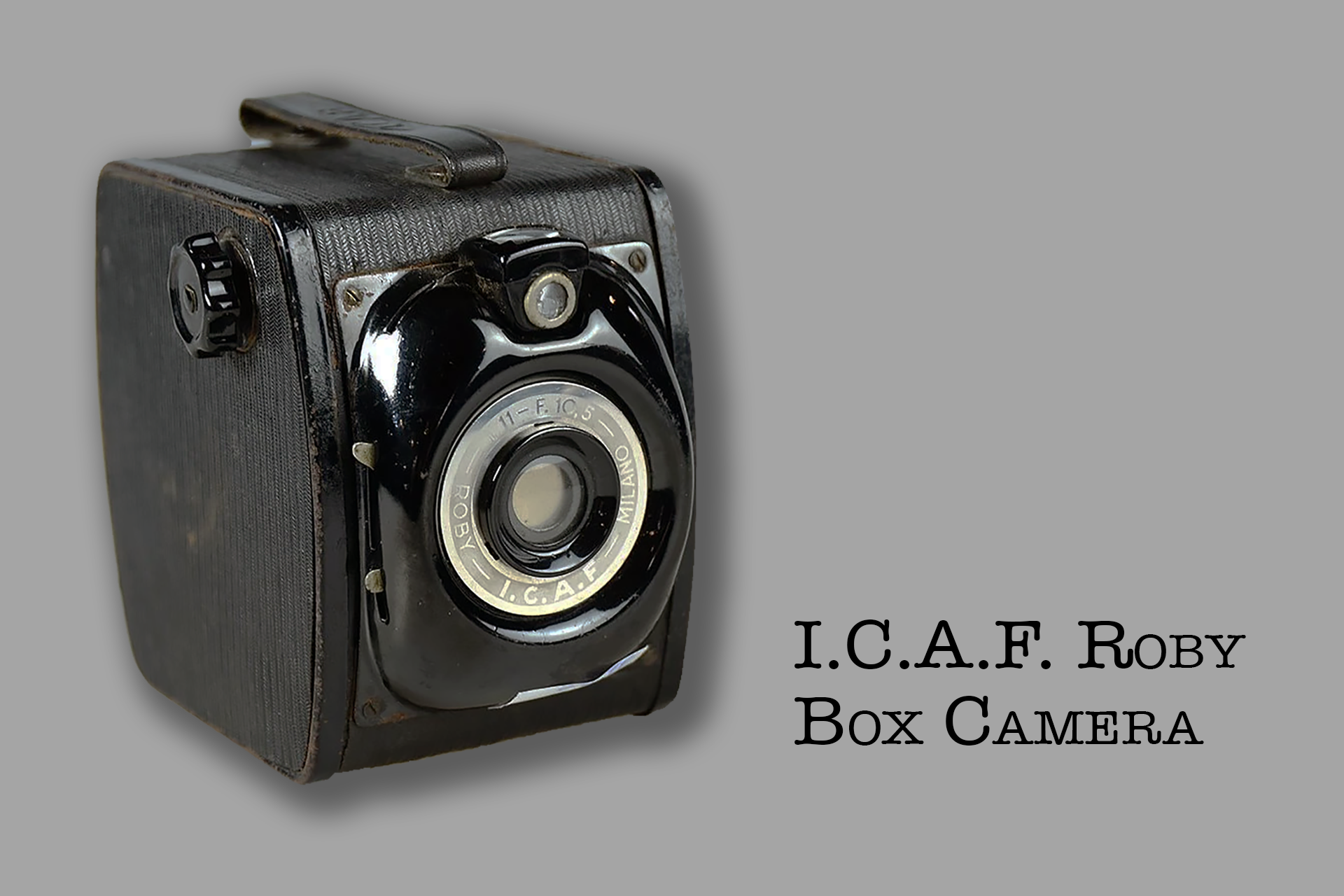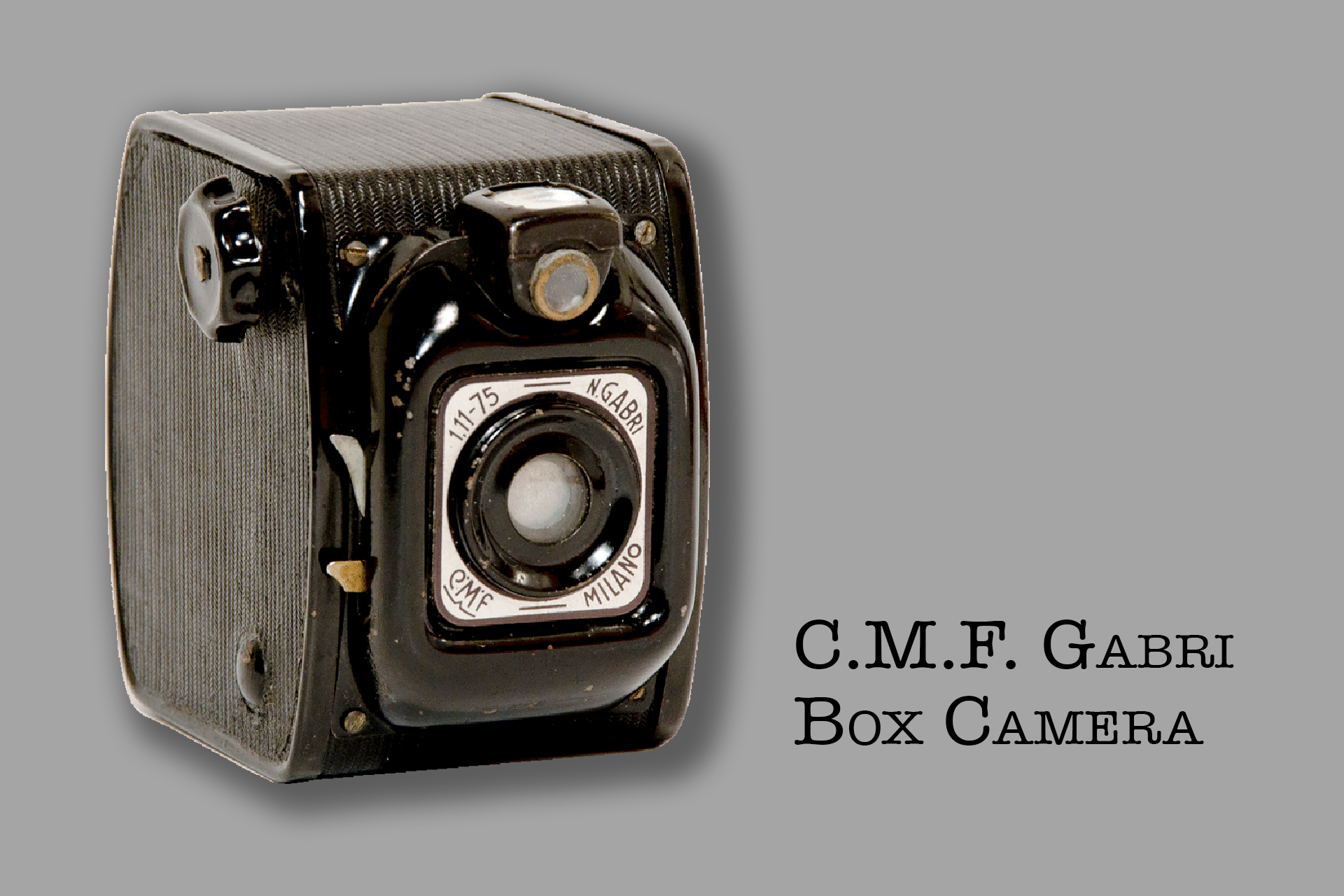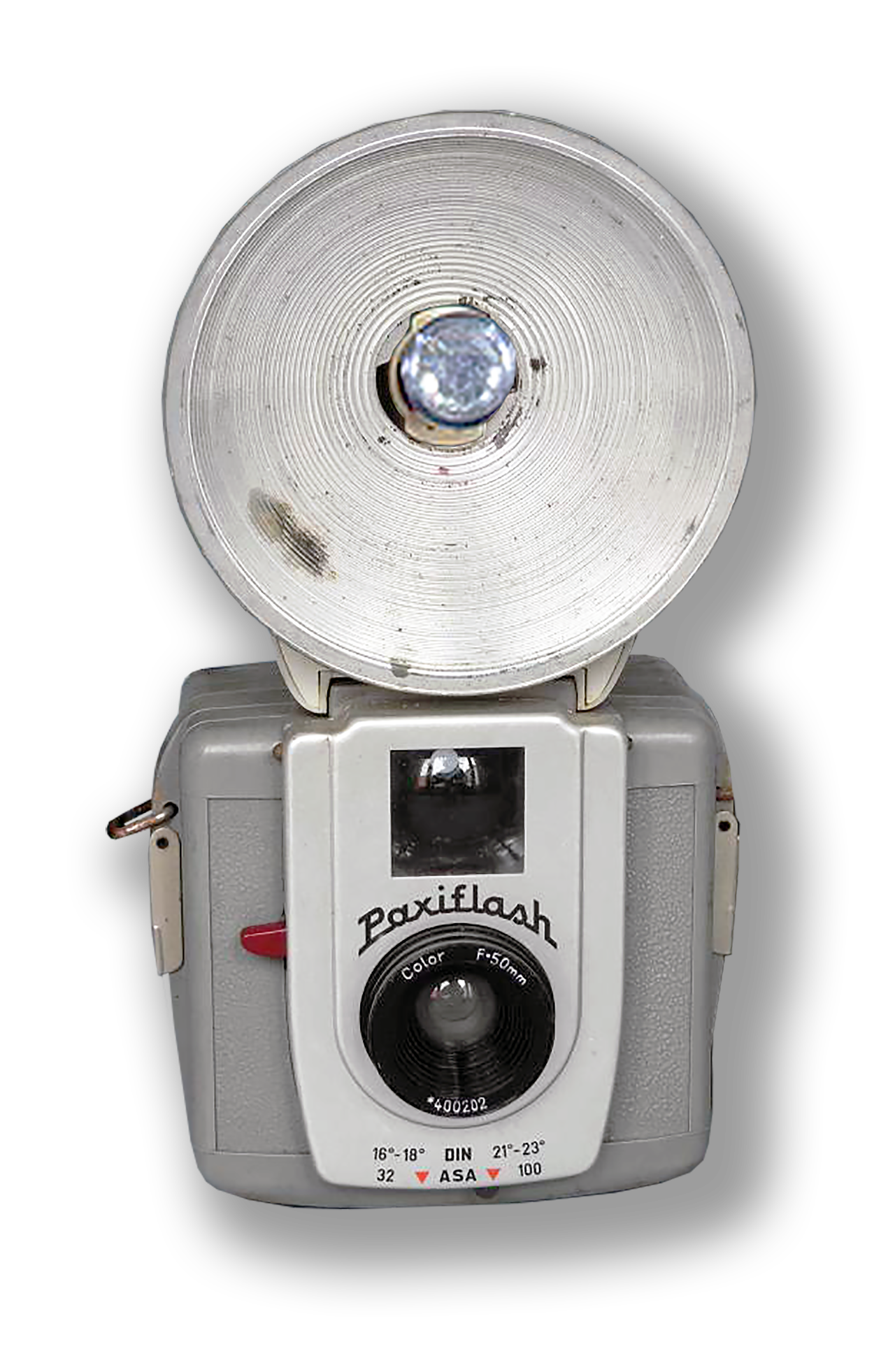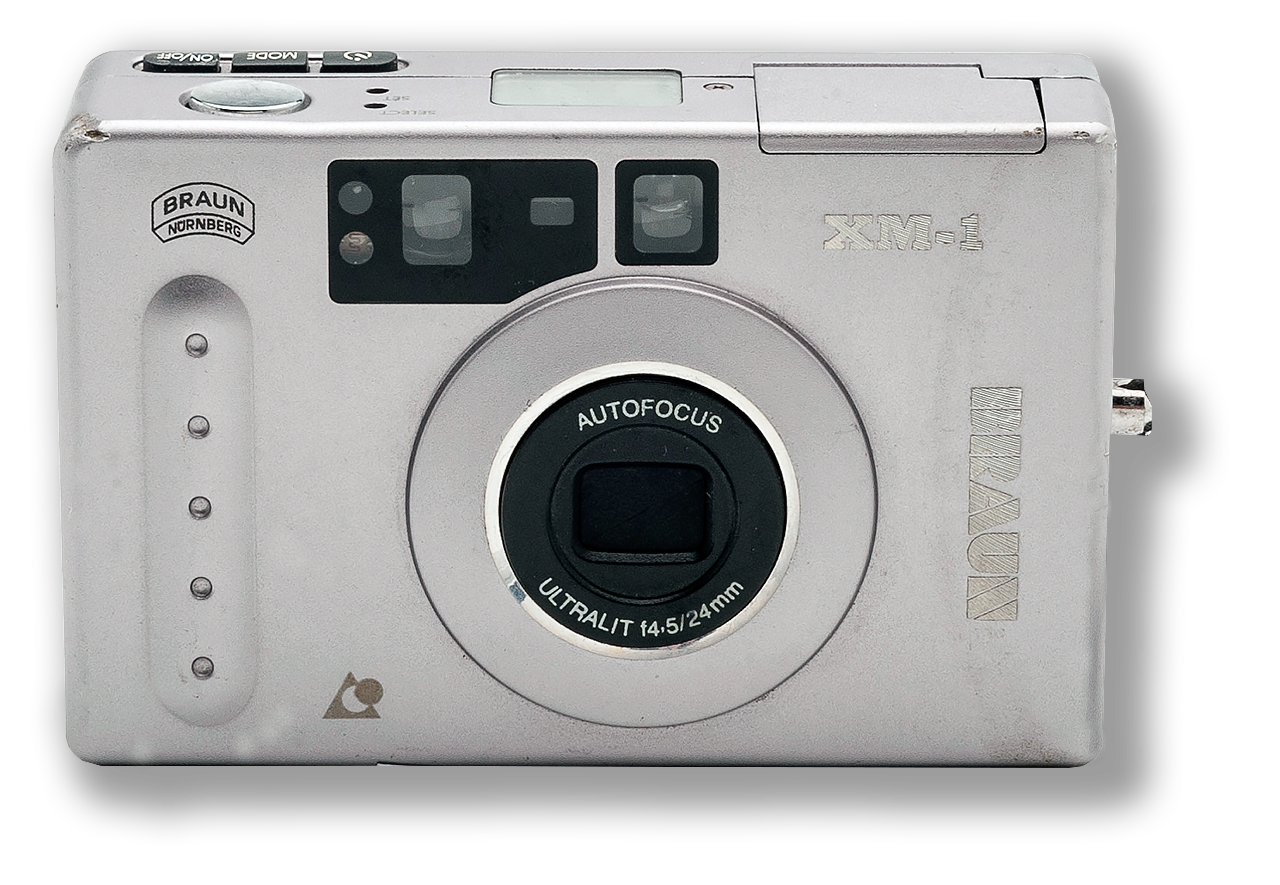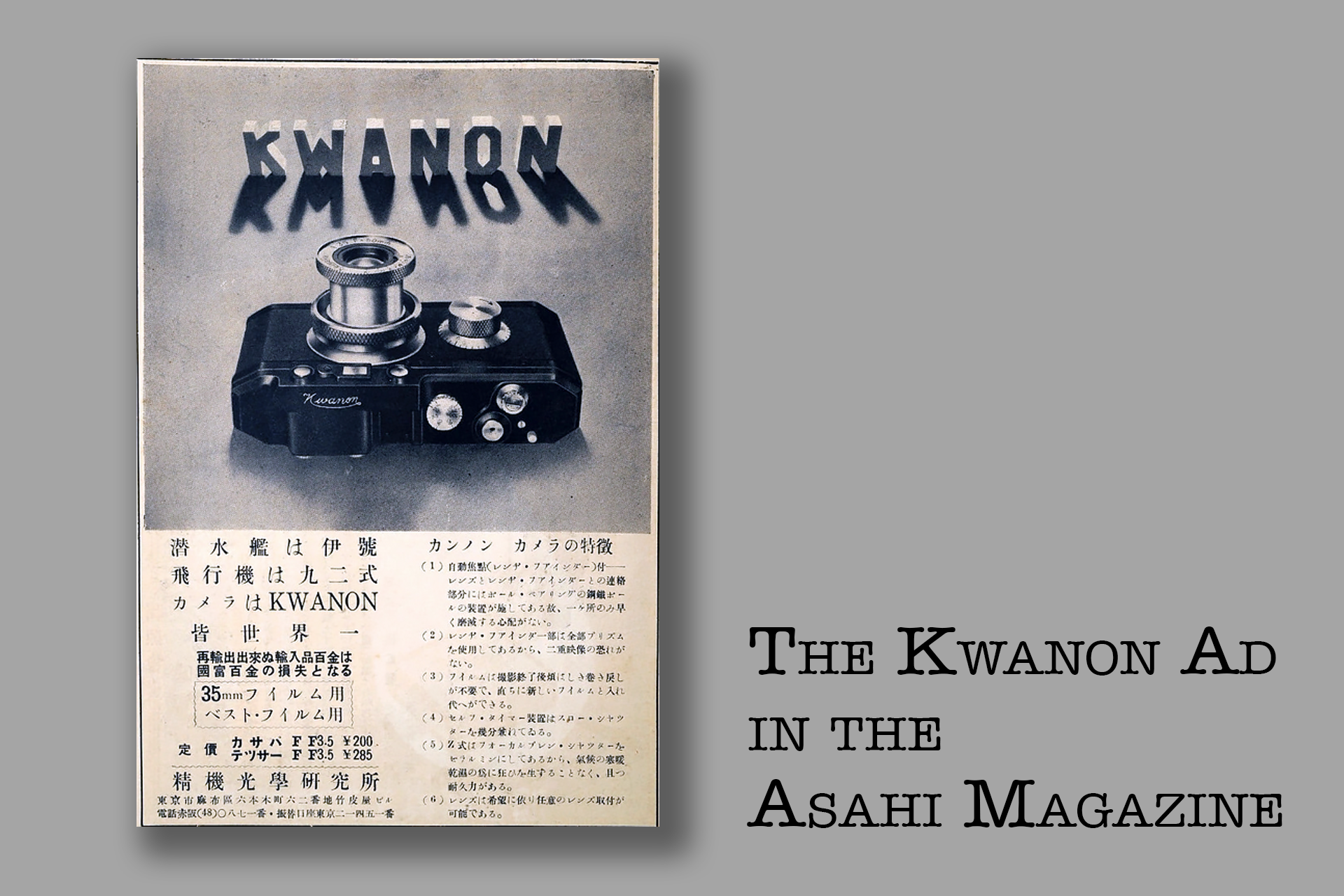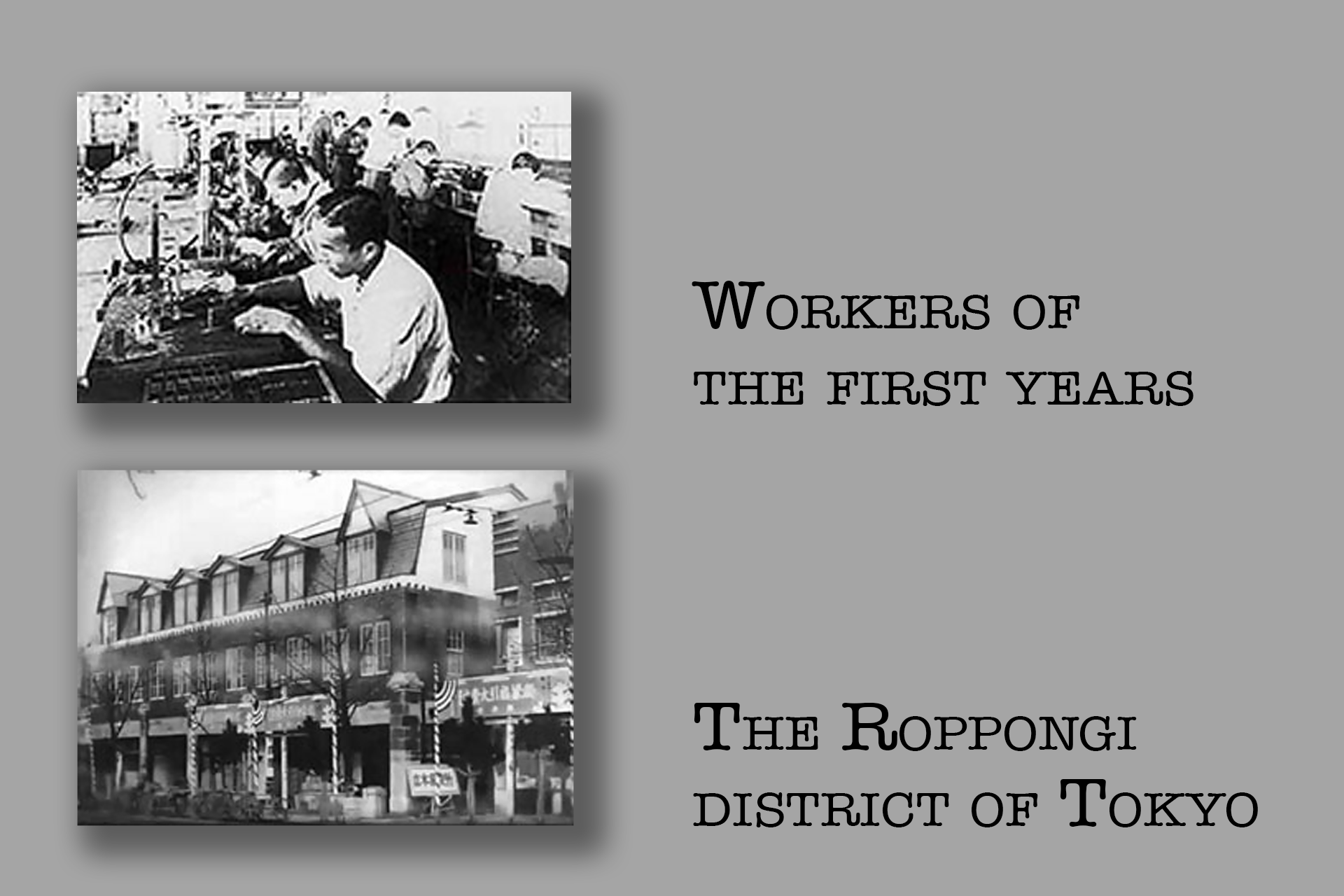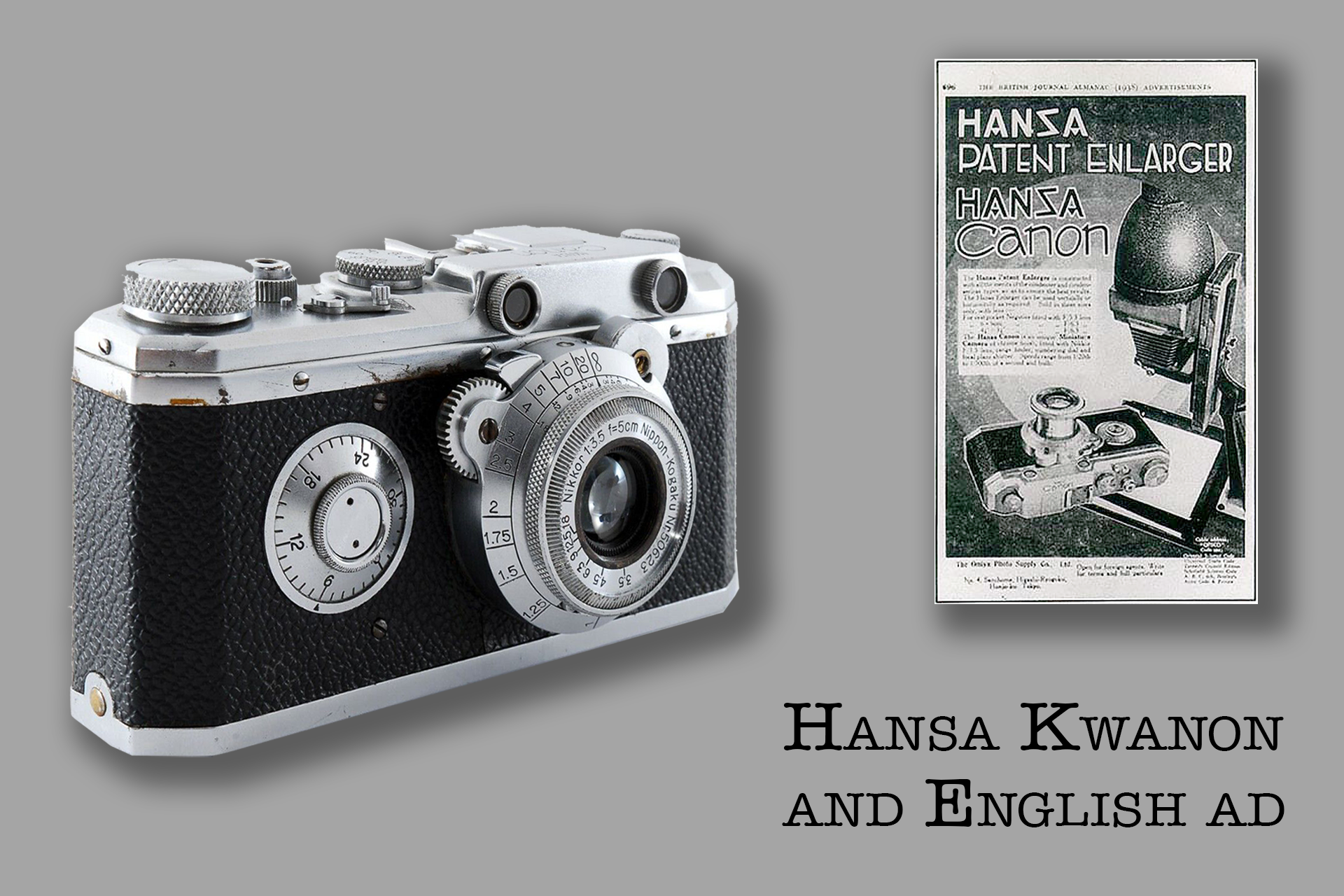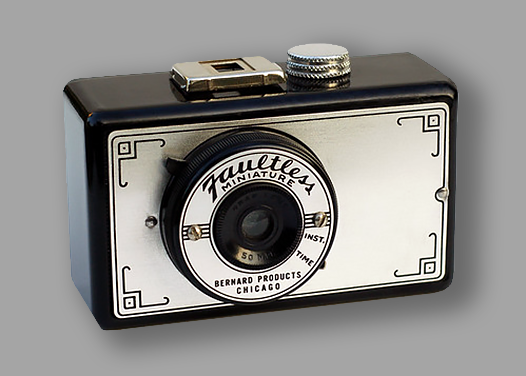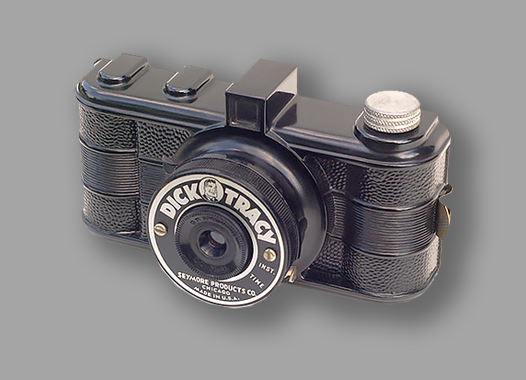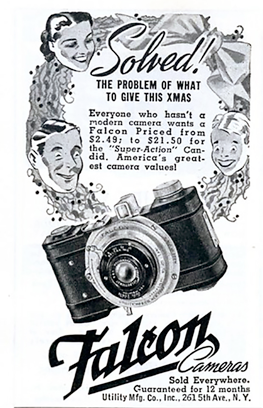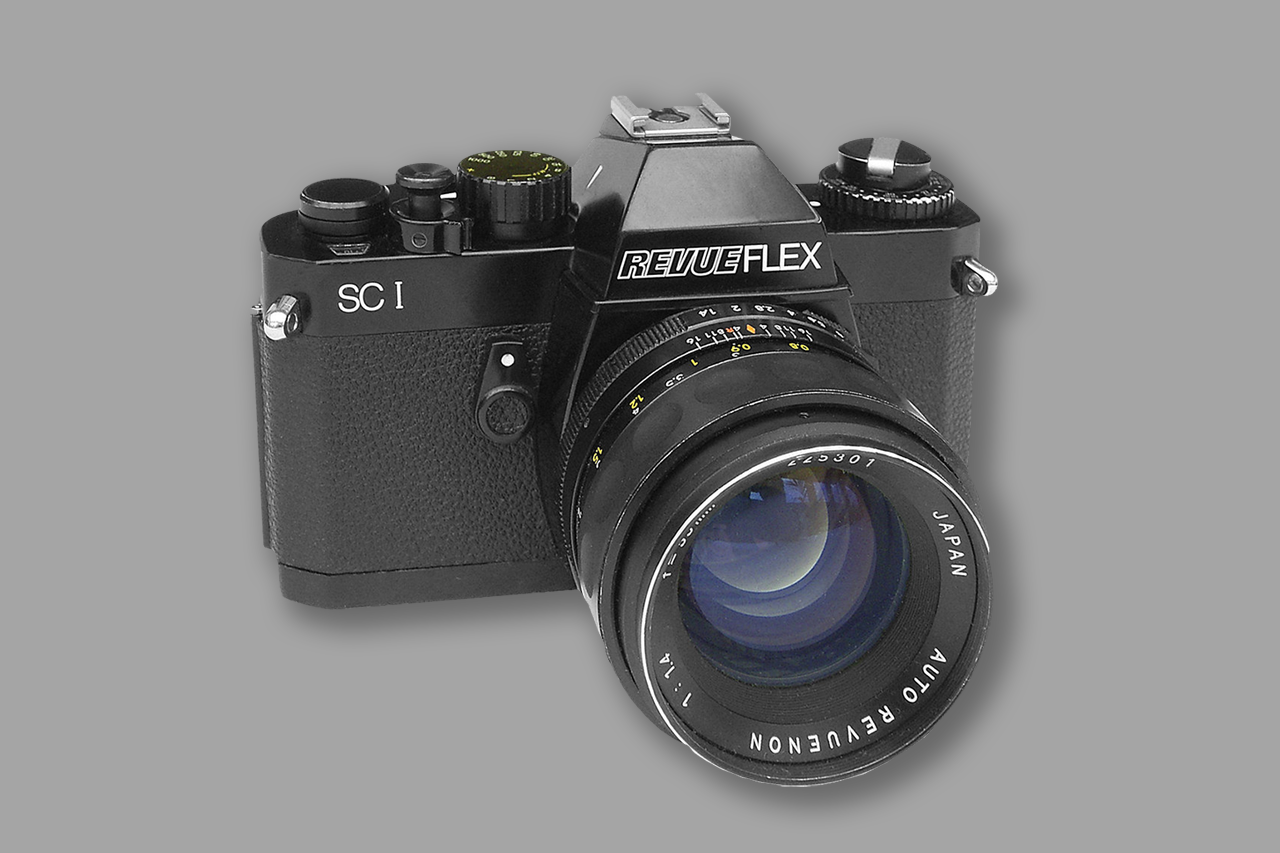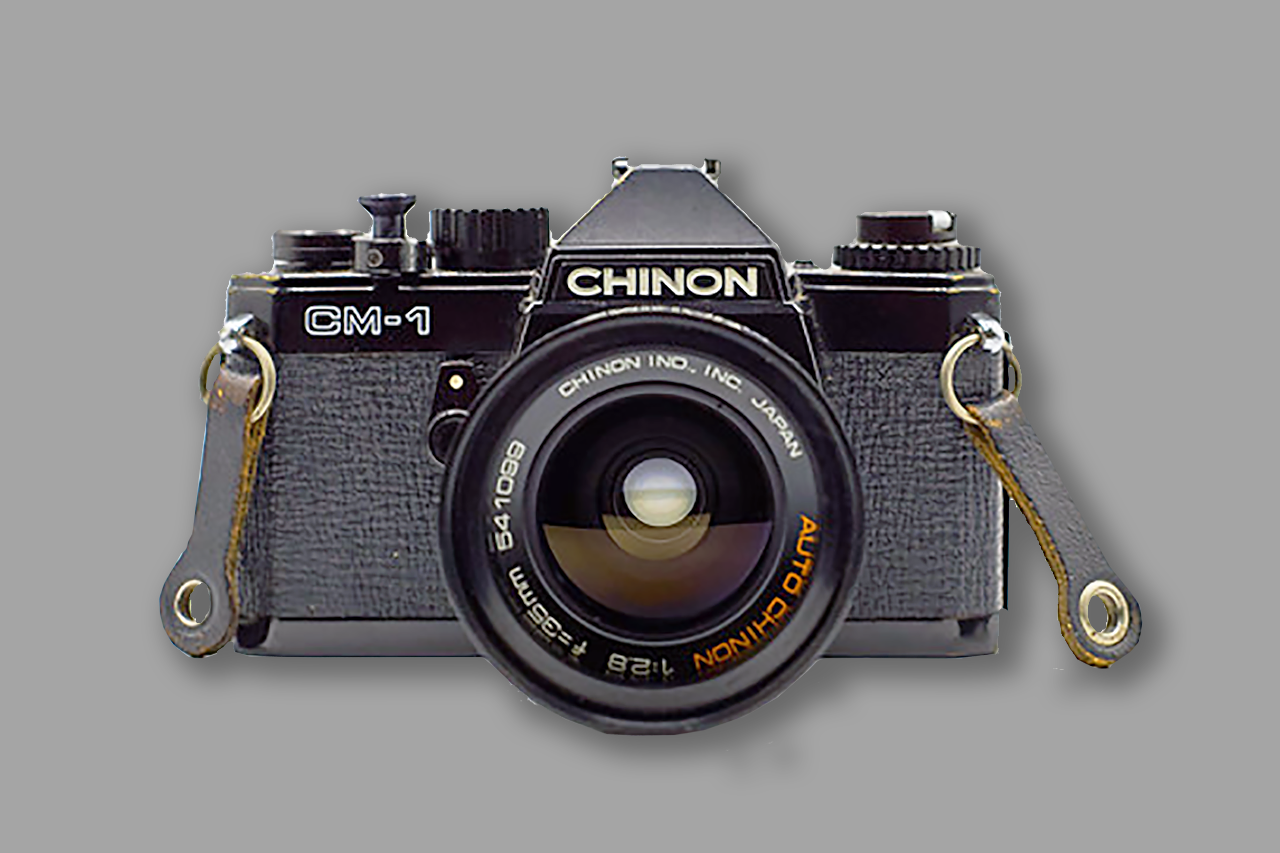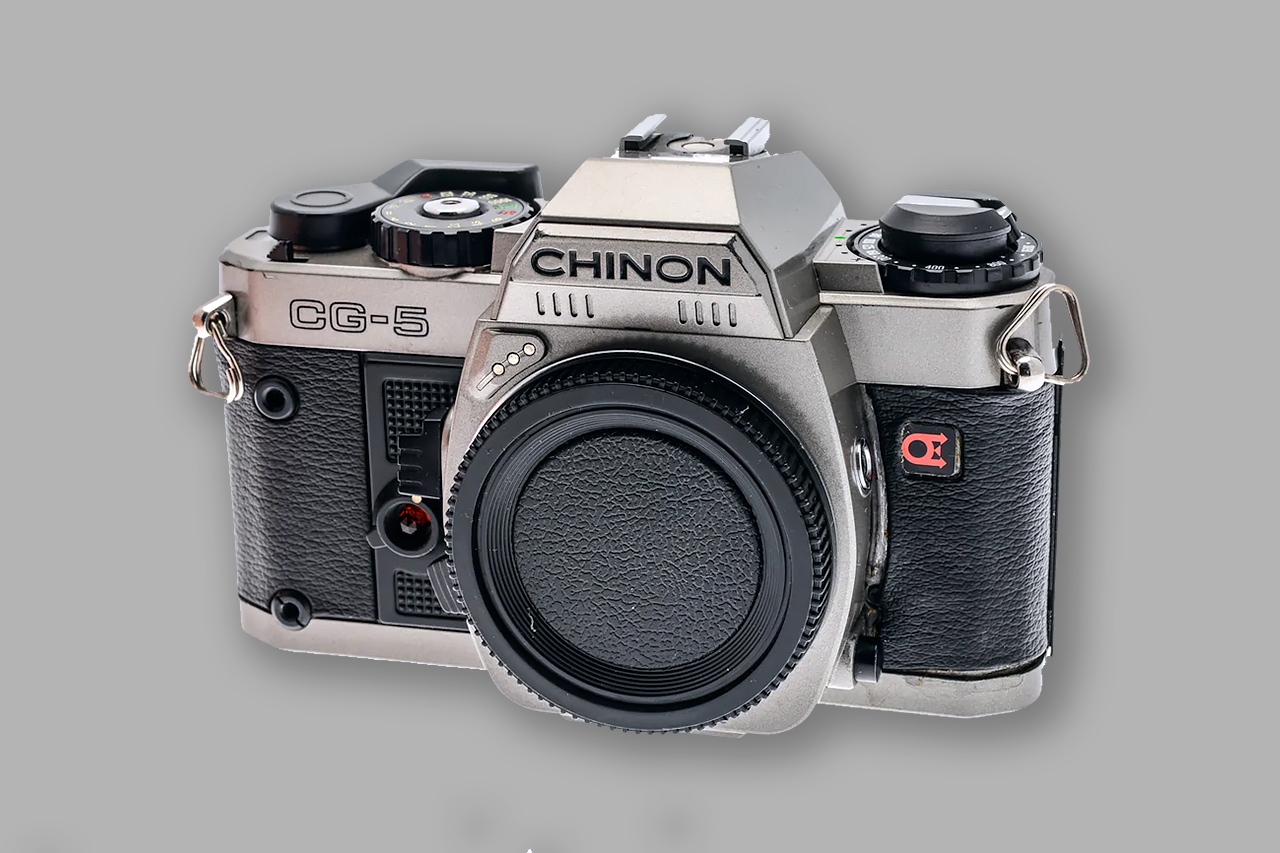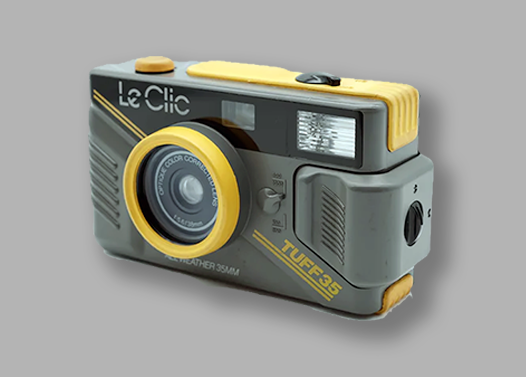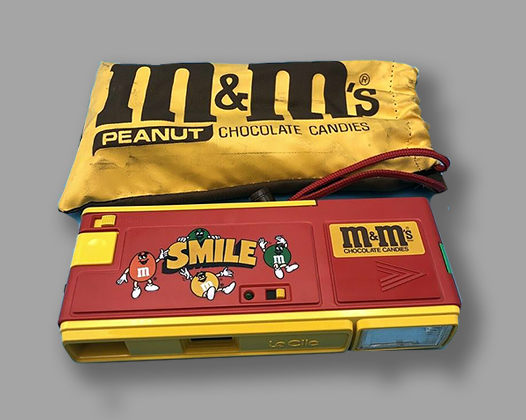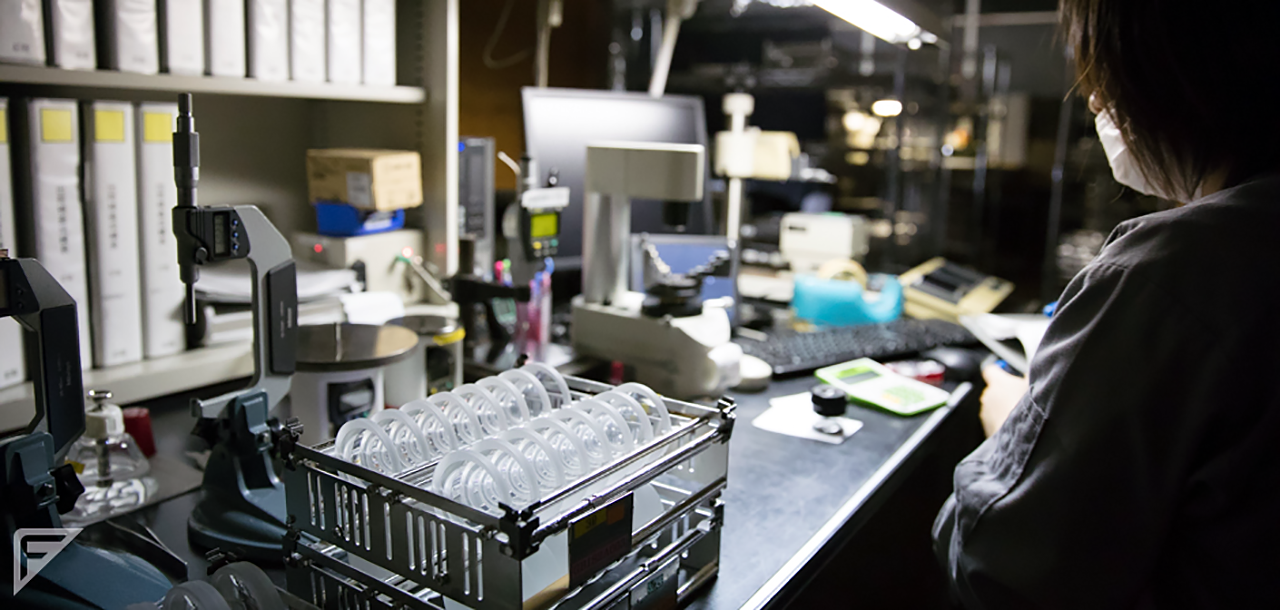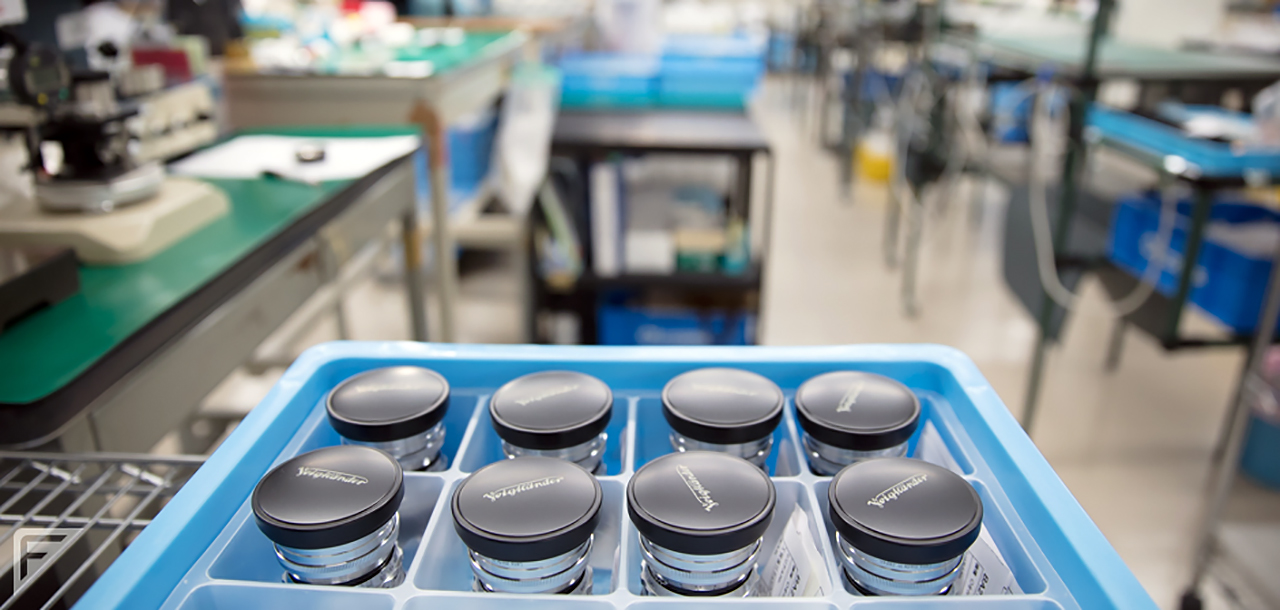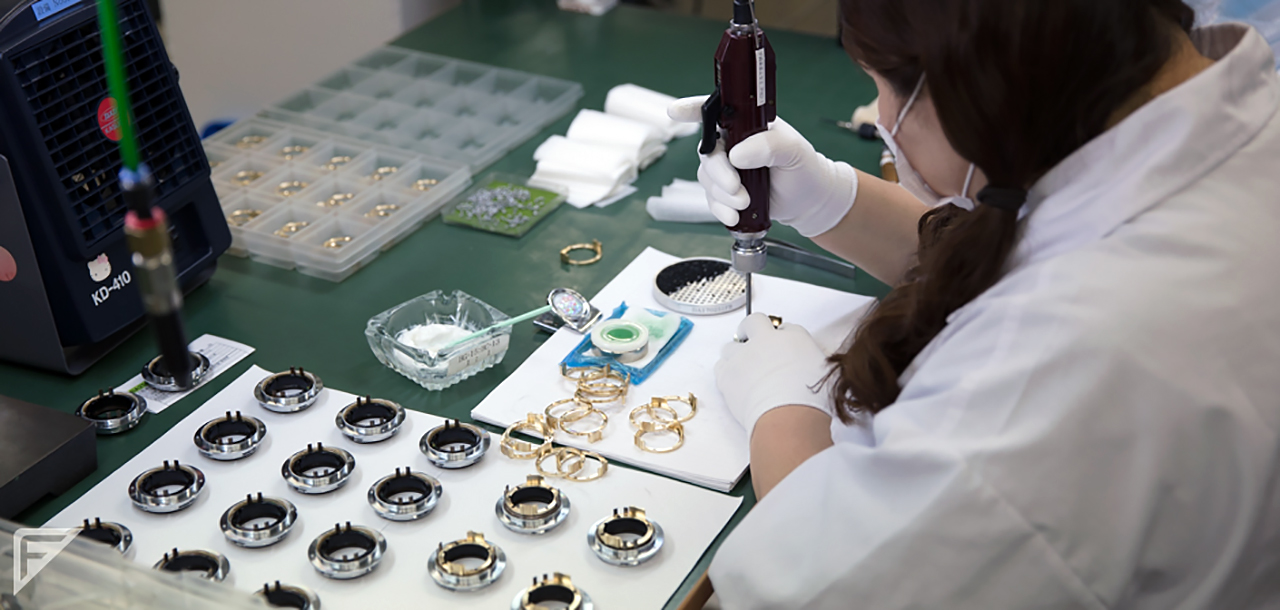Some of the following companies that manufacture(d) photographic material have already passed by in other parts of the site.Here you will find an overview of companies that marketed photographic material in the nineteenth and twentieth centuries.More is usually known about the best known or the most influential companies than about the lesser known ones;therefore they will be discussed more extensively than others.
The emphasis in this part of the site is more on the ups and downs of the company as such, while in other chapters the emphasis was on the product or on the man or woman who founded the company. The order of all companies is alphabetical.
Below are the names of the companies as will be discussed in this or any other chapter. By clicking on a name (so not on the bullet in front of it), you go directly to that part on this page where the manufacturer in question is located. Scrolling is also possible of course, but this service helps you to get to the desired manufacturer in question much faster.
Due to the fact that this introductory page has become much longer than originally planned and desirable due to the large number of manufacturers, we strongly advise you to use the name service below to go to the manufacturer of your choice on this or any subsequent page.
- General Introduction
- ADOX
- Agfa (see also Gevaert)
- Altissa
- Amaloco
- Ansco Camera Co (see also GAF)
- APM/APeM (see also Soho)
Amalgamated Photographic Manufacturers Ltd - Argus Camera Co, Ann Arbor Michigan
- Arsenal (see Kiev-Arsenal)
- Artima Export Ltd (see also Truvox)
- Asahi Pentax
- Bencini
- BOLCo and E Elliott Ltd
(abbrev. for The British Optical Lens Company – See E. Elliott) - Carl Braun Kamera-Werk
- Canon Inc.
- J.T. Chapman, Manchester
- The Chicago Cluster of Companies
(consisting of 56 companies ) - Chinon
- Concord Camera Corp.
- K.G. Corfield & K.G. Corfield (Sales) Ltd.
- Coronet Camera Company
- Cosina Company, Ltd.
- Dacora
- Dixons
- Durst
- EHO-Altissa company (See Altissa)
- E Elliott Ltd and BOLCo
(abbrev. forThe British Optical Lens Company) - Ellison Kamra
(see also QRS Devry Kamra Company) - ELOP
- Ensign Ltd.
(distribution Company of Houghton-Butcher) - Ernemann-Kamerawerke AG
- Expo Camera Company
- The FED Company
- Ferrania
- Fisher-Price
- Fodor
- Foitzik-Kamerawerke
- C.F. Foth
- Fototecnica
- Franka Kamerawerk –
- Fujica (Camera Division of Fujifilm)
- Fujifilm (brief history)
- Futura
- GAF (see also ANSCO)
(abbrev. for General Aniline & Film) - Louis Gandolfi
- Herbert George Company
- Gevaert Photo-Producten N.V. (see also AGFA)
- Girard et Cie
- GNOME
- GOERZ
- GOMZ (LOMO)
- Graflex (Folmer & Schwing)
- Great Wall Plastics Co
- W. Haking Enterprises Ltd.
- Hanimex
- Hasselblad
- Healthways
- Houghton–Butcher Manufacturing Co (See also Ensign Ltd. and Ross-Ensign Ltd.)
- R.F. Hunter Ltd.
- ICA AG
- Ihagee (Exakta)
- Ilford
- Imperial Camera Corporation
(see the Herbert George Company story) - Jos-Pe
- Kamera-Werkstätten Guthe & Thorsch
- Keystone
- Kiev Arsenal
- KMZ
- Kochmann
- Kodak USA (incl. Australia, Canada, France, Germany & the UK)
- Konica-Minolta (Konishiroku)
(see also Minolta) - Kowa
- Krügener
- Kürbi & Niggeloh (Bilora)
- Kyocera (Yashica, Contax)
- Lancaster
- Leitz
- Lensless Camera Manufacturing Company
- Linhof
- Lipca (see also Richter-Tharandt)
- LOMO (see GOMZ)
- Loreo
- Mamiya
- Meopta Optotechnica
- Mimosa AG
- Minolta (see also Konica-Minolta)
- Minox Company
- Miranda (Orion)
- MMZ-BeLomo
- Motodori (Condor)
- Dr. August Nagel Kamera Werke
- Neidig Kamerawerk
- Nemrod-Metzeler (See Healthways)
- Nettel
- Nikon Company
- Nimslo Corporation (see also Nishika)
- Nishika Optical Systems (see also Nimslo)
- Noblex (See also K-W Guthe & Thorsch)
- Olympus Company
- ORION (see Miranda)
- ORWO
- Ottico Meccanica Italiana (OMI)
- Paterson Products Ltd.
- VEB Pentacon Dresden
- Pentax (See Asahi Pentax)
- Petri
- Photavit (Bolta)
- Plaubel
- Polaroid
- Photo Porst
- Karl Pouva – VEB Fototechnik Freital (see also Woldemar Beier)
- Purma Cameras Ltd.
- QRS Devry Kamra Company (see also Ellison Kamra)
- Foto-Quelle
- Rectaflex
- VEB Rheinmetall Büromaschinenwerk
- Richter-Tharandt (see also Lipca)
- Ricoh
- Rollei Germany
- Rollei Singapore
- Ross-Ensign
(continuation from Ensign Ltd.) - Ro-To Company
- Sea&Sea-Sunpak
- Shanghai Seagull
- Sida-Fotofex
- Sigma
- Soho Ltd (see also APM)
- Standard Cameras
- Steinheil
- Stenopeika
- Thornton-Pickard
- Topcon (Tōkyō Kōgaku)
- Tougodo Company
- Traid Corporation
- TRUVOX (see also Artima Export)
- Tura AG
- Universal Camera Corp.
- Vivitar
- Voigtländer
- Vredeborch
- Welta
- Werra (C. Zeiss Jena)
- Wirgin
- Kamera-Fabrik Woldemar Beier (see also Karl Pouva)
- Hermann Wolf GmbH
- Wünsche
- Yashica (see also Kyocera)
- Zeiss Ikon AG
- Zion
- Zunow (Teikoku Kōgaku)
Founding Date:1920
Founder: Antonio Bencini
COMPANY NAMES:
1920 in Florence: Fabbrica Italiana Apparecchi Macchine Materiali Accessori (FIAMMA, also known as FLAME); 1935 in Turin: Filma; 1937 in Milan: ICAF; 1939 in Milan: CMF; 1946 in Milan: CMF – Bencini; 1950 in Milan: Bencini S.p.a.; 1953: Milan: Bencini; 1984: all Bencini production operations ceased.
Company Addresses
1920: Florence; 1935: Turin; 1937: Milan.
Today – although Bencini shut down in 1984, after fiercely holding up against the German and Japanese competition – the brand’s cameras are still in high demand among enthusiasts who love beauty and simplicity.
Like many of his Italian compatriots, Florence-born Antonio Bencini was drafted into World War I. An aeronautical engineer by trade, he was assigned the daunting task of maintaining and repairing old French-made cameras the army scouts relied upon in the field.
After the war, Mr. Bencini returned to Florence and opened a carpentry business that specialized in camera building. In 1920, he and a partner founded Fabbrica Italiana Apparecchi Macchine Materiali Accessori (FIAMMA, also known as FLAME). The business grew steadily, and by 1931 they had 100 employees and occupied a space of 3,000 square meters.
Mr. Bencini, who also served as the company’s technical director, recognized the potential of making and manufacturing amateur box cameras. In 1933, he produced the Fiammetta, a compact wooden camera for image sizes 4.5 x 6 cm and 6 x 9 cm on 120 film.
By 1935, Ferrania, one of Italy’s oldest and most successful photographic firms, purchased FIAMMA, which prompted Mr. Bencini to relocate to Turin, where he began doing business as Filma, and his focus remained on mass production of amateur box cameras.
The first camera to roll off the assembly line was the appropriately named Filma, which took 4.5 x 6 cm images on 127 film, with a fixed f/11 aperture and fitted with a 75 mm meniscus lens. Two years later, the ever-expanding Ferrania obtained Filma, and Mr. Bencini moved to Milan and opened ICAF, which continued the lucrative practice of making and marketing simple and affordable cameras and equipment.
In 1939, ICAF introduced the Roby (later renamed Robi), a compact black enamel camera (4.5 x 6 cm) on 127 film with a fixed aperture of f/11, fixed focus meniscus lens, and a reversible viewfinder mirror. The Gabry (later renamed Gabri) box camera soon followed, also small (4 x 6 cm) on 127 film. Mr. Bencini chose these names to honor his son Roberto and daughter Gabriella.
Shortly before WWII, the company name was changed to CMF. During this period, the company introduced the Argo, Eno, and the Delta (6 x 9 cm) folding camera but soon ceased producing cameras in order to manufacture airplane and bicycle parts for the war.
In 1946, the name was changed to CMF-Bencini, which marked an important camera making transitional phase, with cloth bellows typically associated with a folding camera being replaced by a barrel plate fitted with a mounted lens-shutter lock.
That same year, the Rolet camera (4 x 6 cm on 127 film), constructed by Roberto Bencini, then an architectural student, was introduced. The junior Bencini began assuming more of his father’s leadership responsibilities, and one of his pet projects was designing the Comet camera, a name which reflected his interest in aviation.
Released in 1948, the small and simple Comet camera produced 3 x 4 cm negatives on 127 film. It became one of CMF’s best-selling cameras, and subsequently led to a series of similar cameras, including the Relex, Koroll (and Koroll 24, Koroll 24 S, and Koroll II), Comet II, and Comet III.
In the early 1950s, the name was changed again to Bencini S.p.a. and in 1953, the corporate name was further simplified to Bencini. By the 1960s, this camera-making pioneer had peaked, but the Comet name was resurrected in the 1970s in the form of various types of 35 mm plastic cameras, distinguished by their initials (e.g., K 35, K 36, NK 135, etc.).
The Personal 35 and 8 mm Super 8 film cameras were also being produced in the 1970s, but by now Bencini had clearly lost its competitive edge to the Japanese and German markets. The company continued designing and manufacturing cameras until the late 1984 when business problems led to an announcement that distribution of the company’s product line would be taken over by Cafer Ltd. Cafer released a few more Bencini-branded products until shortly before Antonio Bencini’s death, and then retired the Bencini and Comet brand names.
Many will remember the names of the most successful ones: Gabri, Robi, Rolet, Relex, Koroll, Minicomet, Unimatic, Janua… but Comet always remained the epitome of essential genius. Bencini made also cameras for other brands such as Boots and Trifca.


List of Bencini cameras
127 film
- Bencini Akrom I – a rebadged Comet III
- Bencini Comet
- Bencini Comet II
- Bencini Comet III
- Bencini Comet Rapid
- Bencini Comet S
- Bencini Cometa
- Bencini Minicomet
- Bencini Relex
- Bencini Rolet
- Bencini – Koroll 35
- Bencini 1960 Koroll 24
- Bencini 1953 in aluminium
126 film
110 film
- Comet 110
- Comet 310
120 film
- Argo
- Bencini Eno
- CMF Erno
- CMF Gabri
- Bencini Koroll 24S
- Bencini Koroll II
- Bencini Koroll S
- Bencini Koroll T
35mm film
- Bencini 435 electronic
- Bencini Comet K 35
- Bencini Comet NK 135
- Bencini Personal Reporter

Founder: Karl Braun
COMPANY NAMES:
1906: Karl Braun, optical and metal goods manufacturing; 1932: Death of the company founder and takeover by his sons Willy as commercial manager and Carl Braun as technical manager; 1933: Karl Braun KG, Nuremberg, Germany; 1948: Karl Braun Camera Werk; 1968: End of camera production in Germany and production in the Far East; 1986: Carl Braun Camera-Werk GmbH; 2002: Successor Company: Braun Photo Technik GmbH.
COMPANY ADDRESSES:
1906: Kohlehofstrasse 46, Nuremberg; 1914: Gertrudstrasse 21, Nuremberg; 1934: Gertrudstrasse 19-23, Nuremberg; 1936: Muggenhofer Straße 122, Nuremberg; 1986: Kohlenhofstrasse 3, Nuremberg; 2002: Klingenhofstrasse 72, Nuremberg; 2016: Merkurstrasse 8, 72184 Eutingen.
Braun (Carl Braun Kamera-Werk) of Nürnberg, Germany, was originally founded in 1906 as an optical and precision engineering company which manufactured semi-finished parts for the radio industry and binoculars.

One of the first post-war cameras was the Braun Imperial (1948).

A vintage Braun Paximat slide projector with transport case.

The first Paxettes (ca. 1950) were compact viewfinder cameras not unlike the Voigtlander Vito B, although they lacked wind levers, having wind knobs instead.

The Braun Multimag SlideScan 6000 slide magazine scanner with very high resolution

The Braun Paxette Reflex single lens reflex camera series was made from 1958 to 1962, broadly similar to the Paxette Rangfinder cameras.

About 1948, after the war and the currency reform, the company was renamed to Karl Braun Camera Factory and began producing box cameras, in roll film and 35mm format. Its best known cameras are the Paxette series of 35mm rangefinder cameras. Most of the company’s cameras were consumer-level models, though the company did briefly produce several more advanced 35mm rangefinder designs as well as an interesting 35mm SLR line with leaf shutters, the AMC/Paxette Reflex.
The most advanced of Braun’s rangefinders and SLRs had interchangeable lenses and built-in light meters. In 1956 more than 1,000,000 Braun cameras had been made. Braun ceased making cameras in the 1960s, in part because of high labour costs and a resultant inability to compete in the consumer level camera market.
Parallel to the camera production began the development and construction of slide projectors. This would become a mainstay of its business for the next forty years. In 1955, under the brand name Paximat, the company launched one of the first semi-automatic slide projectors with a magazine. Other innovations in the slide projector technology were devices with cable or remote control, with automatic focus, the use of even brighter halogen lamps and devices with step less brightness control of the projection lamp.
In 1983 the Paximat Multimag was the sensation in the slide projector market. For the first time it was possible to use all major magazine systems in a slide projector.
Among the high-quality Paximat Multimag models, the inexpensive slide projectors of the Novamat series have also established themselves in the market. Above all, the Novamat devices with built-in daylight screen enjoyed great popularity.
The company began to focus on its established line of slide and optical projectors, selling over 1,000,000 slide projectors up to 1966, more than 4,000,000 up to 1997 worldwide in 120 countries. In the 1970s Japanese-made Braun Super-8 cameras were sold, and the company was the distributor for Konica cameras. Brought-in cameras are still distributed by Braun today.
The range of slide accessories, such as fade-control units, high-quality projection lenses, projection screens, projection tables, slide frames, slide magazines and an automatic slide-on device, has also been expanded around the slide projector program. By incorporating state-of-the-art overhead projectors in 1999, the Braun projection program was systematically expanded.
In addition to the successful introduction of Braun digital cameras and digital accessories, the Braun Multimag SlideScan 3600 has caused a stir in the market since mid-2003. This scanner was developed on the basis of the Paximat Multimag slide projectors and, for the first time, enables slides to be scanned directly from six different slide magazines.
The Braun Multimag SlideScan slide-on slide scanner thus bridged the gap between conventional slide photography and the digital medium, which would become an important pillar for the company in the future.
In 2004, the company changed its name to Braun Photo Technik GmbH, moved into new premises in Nuremberg and from that point on began to expand its range as a full-range provider in the multimedia sector.
The successor of the Braun Multimag SlideScan 3600, the model Braun Multimag SlideScan 4000 followed in March 2005 and in 2012 the Braun Multimag SlideScan 6000, consistent further developments now with even higher resolution, digital ICE technology or Magic Touch dust and scratch removal, as well as a higher scanning speed.
In 2006, the success story around the topic of digital picture frames started, which continues to this day and is an example of the long-term product cycles at Braun. As of 2007, the Braun binoculars made a very successful return to the diverse product range and continue to enjoy uninterrupted popularity.
Early on, Braun was one of the first to offer a trendy action cam with an underwater housing for a broad group of buyers. The first model was already launched in the market in 2010, whereby the portfolio of action cams is constantly being updated to this day. In 2016, the move to a newly completed service center in Baden-Württemberg took place at the following address: Merkurstrasse 8, 72184 Eutingen.
- 1906
- Founded in April as Karl Braun, optical and metal goods manufacturing (entry in the City of Nuremberg trade register) by Karl Braun (born 1878, died 1932) at Kohlehofstrasse 46. He lived at Sandstrasse 3 at the time.
- Products: Semi-finished products for the radio industry, e.g. aluminum sleeves for condensers and binoculars
- 1914
- Move to larger rooms in a building in Gertrudstrasse 21
- 1932
- Death of the company founder and takeover of the company by his sons Willy (born 1907, died July 29, 1981) as commercial manager and Carl Braun as technical manager
- 1933
- Transformation into a limited partnership as Carl Braun KG with entry in the commercial register on March 23, 1933. The two sons are personally liable partners and the mother Hedwig Braun is limited partner
- 1934
- Lease of additional buildings.
- Company address: Gertrudstrasse 19-23
- 1935
- Acquisition of 11,738 sqm of land in Muggenhoferstrasse 122
- 1936
- Relocation to the new company building
- Second World War
- Production had to be forced to switch to war-related equipment. Only minor damage to the factory buildings during World War II
- 1945
- Repair of war damage and production of necessities
- 1948
- Carl Braun Camera Werk. Production of box cameras “Imperial” and “Ideal”
- 1950
- Production of tube cameras “Pax” and “Paxina”
- 1951
- construction of new buildings.
- Production of roll film cameras “Norca” and “Paxette” 35mm cameras.
- Braun Paxette I
- 1953
- Hedwig Braun (the widow of the company founder) dies and is no longer a limited partner. The company will be continued as an open trading company.
- 1955
- Production of semi-automatic slide projectors “Paximat” with a magazine system.
- Brown Paxette Ib
- 1957
- Extension of the buildings by the east wing
- 1958
- Production of SLR cameras “Paxette-Reflex”
- 1968
- End of camera production in Germany and production in the Far East
- 1986
- Registration as Carl Braun Camera-Werk GmbH,
- Kohlenhofstrasse 3
- 1999
- Overhead projectors expanded systematically the Braun projection program
- 2002
- Entry in the commercial register as Braun Photo Technik GmbH, Klingenhofstr. 72 in Nuremberg by Hans-Dieter Schock. Sales of cameras, slide projectors, tripods, binoculars, photo scanners, etc.
- 2003
- The Braun Multimag SlideScan 3600 slide magazine scanner
- 2004
- The company changed its name to BRAUN Photo Technik GmbH, moved into new premises in Nuremberg
- 2005
- The successor model Braun Multimag SlideScan 4000 followed
- 2007
- Return of the BRAUN binoculars
- 2010
- Action cam with an underwater housing
- 2012
- The Braun Multimag SlideScan 6000 slide magazine scanner with higher resolution
- 2016
- Move to a newly completed performance center in Baden-Württemberg

Artist impression of the new performance center of Braun in Baden-Württemberg.

Braun Reporter variant, 6×9, Film 120, built for Kaufhof AG., 1950.

Rothlar Gazelle viewfinder camera for 35mm film built for Rothlar-Optik, Walter Roth, near Nuremberg. The camera is identical to the Braun Gloriette except for the lens and shutter.
- Rangefinder
- Gloria
- Folding
- Norca
- Imperial (folding)
- Box
- Color Box
- Ideal
- Imperial
- Compact viewfinder cameras
- Pax
- Paxina
- SLR
- Paxette Reflex
- rebadged Chinese SLR bodies: Braun SR2000 PK, SR2000 MD, SR2000 Y
- Rangefinder
- Super Colorette (rebadged versions sold by Wittnauer as the Professional and Continental, and by Sears)
- Paxette and Super Paxette
- Viewfinder
- Candy M2 Motor
- CB 35 M / CB 35 M-AF
- Gloriette
- Handy
- New Handy
- Paxette electromatic
- Trend Micro SM
- Paxina Electromatic
- Paxiflash
- Braun Automatic 300
- Paxette 28 (1965-68)
- Paxette 28 Auto (1967)
- Paxette 28B (1967)
- Paxette 28BC (1967)
- Paxette 28F (1967)
- Paxette 28LK (1967)
- Braun XM-1
FOUNDING DATE: 1937 (1934)
FOUNDERS: Takeshi Mitarai, Goro Yoshida, Saburo Uchida and Takeo Maeda
COMPANY NAMES:
1934 Precision Optical Instruments Laboratory Co. (Seiki-Kogaku Kenkyusho); 1937: Precision Optical Industry Co Ltd. (Seiki-Kogaku Kenkyusho); 1947: Canon Camera Co., Inc.; 1969: shortened to Canon Inc.
COMPANY ADDRESSES:
1934: Rappongi district of Tokyo; 1952: Shimomaruko;
The origins of Canon date back to the founding of Precision Optical Instruments Laboratory in Japan in 1937 by Takeshi Mitarai, Goro Yoshida, Saburo Uchida and Takeo Maeda. The name Canon comes from Buddhist bodhisattva Guan, (Kannon in Japanese), previously transliterated as Kuanyin, Kwannon, or Kwanon in English.
In 2022 Canon was celebrating its 85th anniversary. The seed was planted in 1934 when a company called Seiki-Kogaku Kenkyusho placed an advert for a camera called the “Kwanon” in the Asahi Camera magazine.
 The company, whose name translates as Precision Optical Instruments Laboratory, was formed by movie camera repairman Goro Yoshida, who wanted to develop the first Japanese 35mm rangefinder camera in a world where European brands like Leica and Contax, dominated.
The company, whose name translates as Precision Optical Instruments Laboratory, was formed by movie camera repairman Goro Yoshida, who wanted to develop the first Japanese 35mm rangefinder camera in a world where European brands like Leica and Contax, dominated.
To see how these cameras worked he reportedly took apart a Leica Model II, and Canon’s history pages quote him as saying ‘I just disassembled the camera without any specific plan, but simply to take a look at each part. I found there were no special items like diamonds inside the camera. The parts were made from brass, aluminum, iron and rubber. I was surprised that when these inexpensive materials were put together into a camera, it demanded an exorbitant price. This made me angry‘.
Yoshida formed Seiki-Kogaku Kenkyusho with his brother-in-law Saburo Uchida and Takeo Maeda, and the company worked from a room in a small streetside shop in the Rappongi district of Tokyo.
The advert for the Kwanon appeared in June 1934, after three different prototypes had been made or just designed – no actual product ever appeared, and the Kwanon was never brought to market.
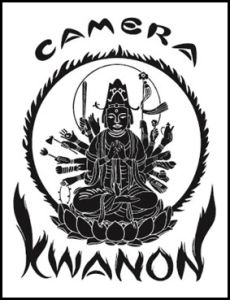 Yoshida called the camera Kwannon, the Buddhist goddess of mercy, bodhisattva Guan, (Kannon in Japanese), previously transliterated as Kuanyin, Kwannon, or Kwanon in English), hoping the deity would share her benevolence as they pursued their dream to produce the world’s finest camera.
Yoshida called the camera Kwannon, the Buddhist goddess of mercy, bodhisattva Guan, (Kannon in Japanese), previously transliterated as Kuanyin, Kwannon, or Kwanon in English), hoping the deity would share her benevolence as they pursued their dream to produce the world’s finest camera.
The camera’s lens, called Kasyapa—after Mahakasyapa, a disciple of Buddha—also took its name from Buddhism.
Additionally, the top portion of the camera body featured an engraving depicting the thousand-armed Kwannon.
Yoshida left the company shortly after the adverts appeared, as a result of a disagreement about the future of the business. In 1936, two years after the birth of the Kwanon and following much trial and error, Canon launched the Hansa Canon, its first commercial 35mm focal-plane-shutter camera, thus embarking on the Company’s history as a camera manufacturer.
This camera was created through collaboration with a military optical equipment company called Nippon Kogaku Kogyo (which became Nikon). The Hansa Canon used a Nikkor 50mm f/3.5 lens, and a lens mount, rangefinder mechanism and viewfinder optical system made by the company that is today its greatest rival in the camera business. In 1940 Canon developed Japan’s first indirect X-ray camera.
Canon counts August 10 1937 as the official founding of the company, when Precision Optical Industry Co Ltd was formed as a joint-stock company. The word ‘Canon’ wasn’t used in the company name until 15th September 1947 when it became Canon Camera Co Ltd – to help American servicemen to identify the cameras with the company that made them.
The Post-War period
During the Post-War period, two major events took place that affected the destiny of the development of Precision Optical Industry Co., Ltd. One major event was the change of the company’s name to Canon Camera Co. Ltd., and the other was the move of the Head Office Plant to Shimomaruko.
Those days, there were many camera-loving personnel in the Allied Occupation Forces who complained that product branding was very confusing: Canon for cameras, Serenar for lenses, and Precision Optical Industry for the manufacturer of these products. Some of them came to Meguro looking for Canon cameras and found it difficult to remember that the name of the company they were looking for was Precision Optical Industry.
Responding to these complaints, and in view of the need to make the company easily recognizable internationally, President Mitarai decided to change the company’s name to Canon Camera Co., Ltd. as of September 15, l947. After this change, the names of the manufacturer and the camera were unified under Canon, and the Serenar lens brand was also changed to the Canon in l953.
A trip to the USA
President Mitarai made a trip to the United States in August l950, three years after the change in company name, to observe the international trade fair and study the trends in the camera market. He was also looking for the opportunity to establish a sales network in the United States. In order to seek their cooperation in Canon’s sales in the United States, he visited Bell and Howell Company, a well-established company with advanced technology as well as a sales network in the area of 8mm and 16mm cinecameras and projectors.
Unfortunately, his request was turned down, in spite of the fact that Bell and Howell recognized the excellent quality of Canon’s high-end 35mm cameras. The major reasons for the rejection were that the Canon cameras were made in Japan, and that Canon’s factories were all wooden buildings that could easily catch fire.
Although his sales plan in the U.S. Market did not materialize, Mitarai’s visit to the United States was not entirely in vain. In fact, Canon benefited greatly not only by the valuable information gathered about the latest status of the world’s camera industry, but also by recognizing the need for a new fire-proof factory building with the most modern facilities.
In June, the company, looking for new factories, purchased and started remodeling the plant site of the former Fuji Aviation Instruments Co., Ltd., located in Shimomaruko, Ohta Ward in Tokyo. Beginning in November l951, Canon started reorganising its head office divisions located in Ginza, Meguro factory and Itabashi factory, and gradually moved their major functions to the new Shimomaruko Head Office Plant.
The new plant in Shimomaruko was very colorful and modern, employing different colours for different workplaces. With the completion of the Shimomaruko Plant, the foundation for a modernised Canon company with the worldwide market in view was established.
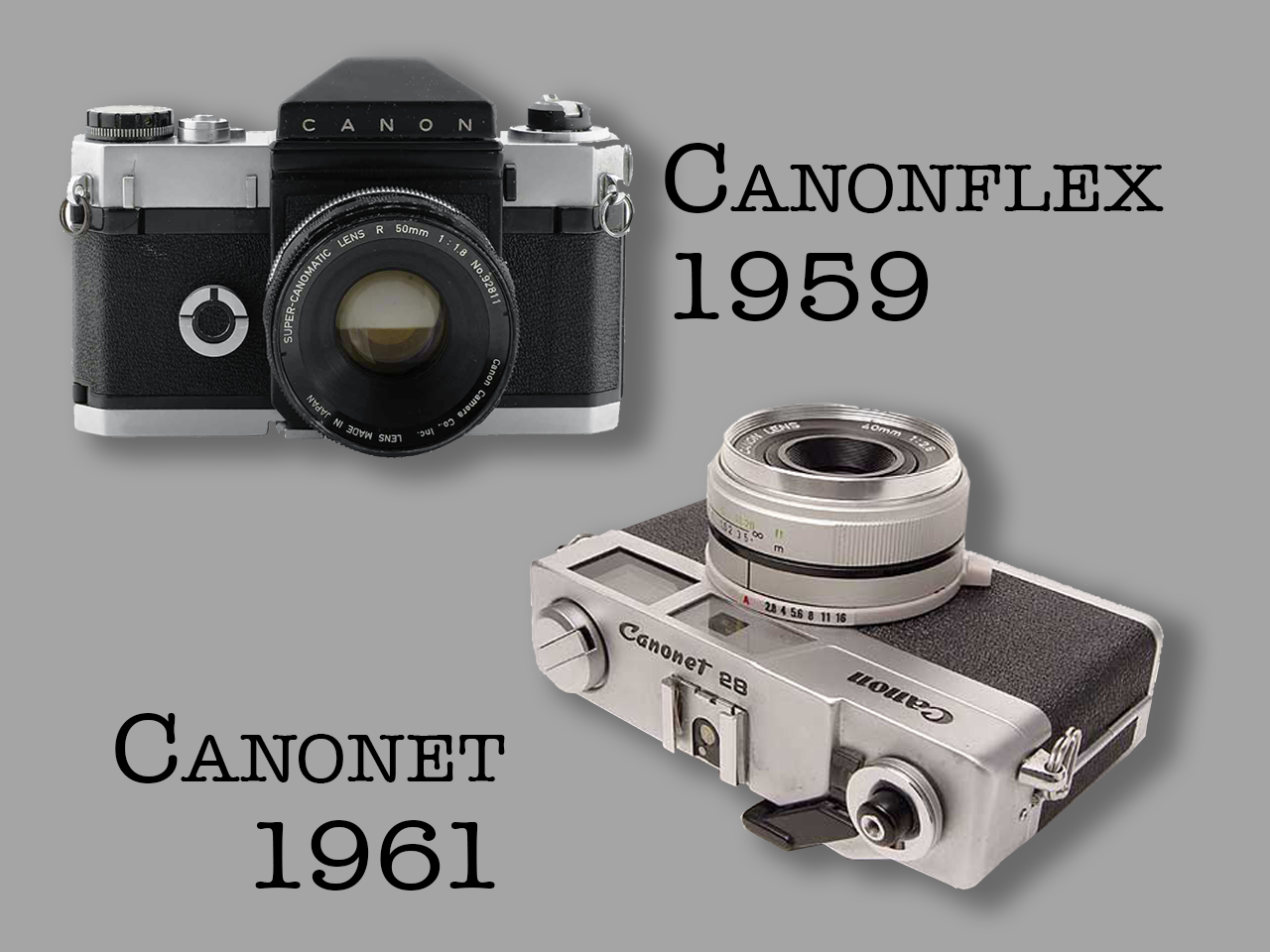
The Canonflex was introduced in May, 1959. The camera stayed in production for one year before it was replaced by the Canonflex R2000, adding the 1/2000 sec. shutter speed and the thumb operated wind on operation. It was followed by the rangefinder camera Canonet in 1961.
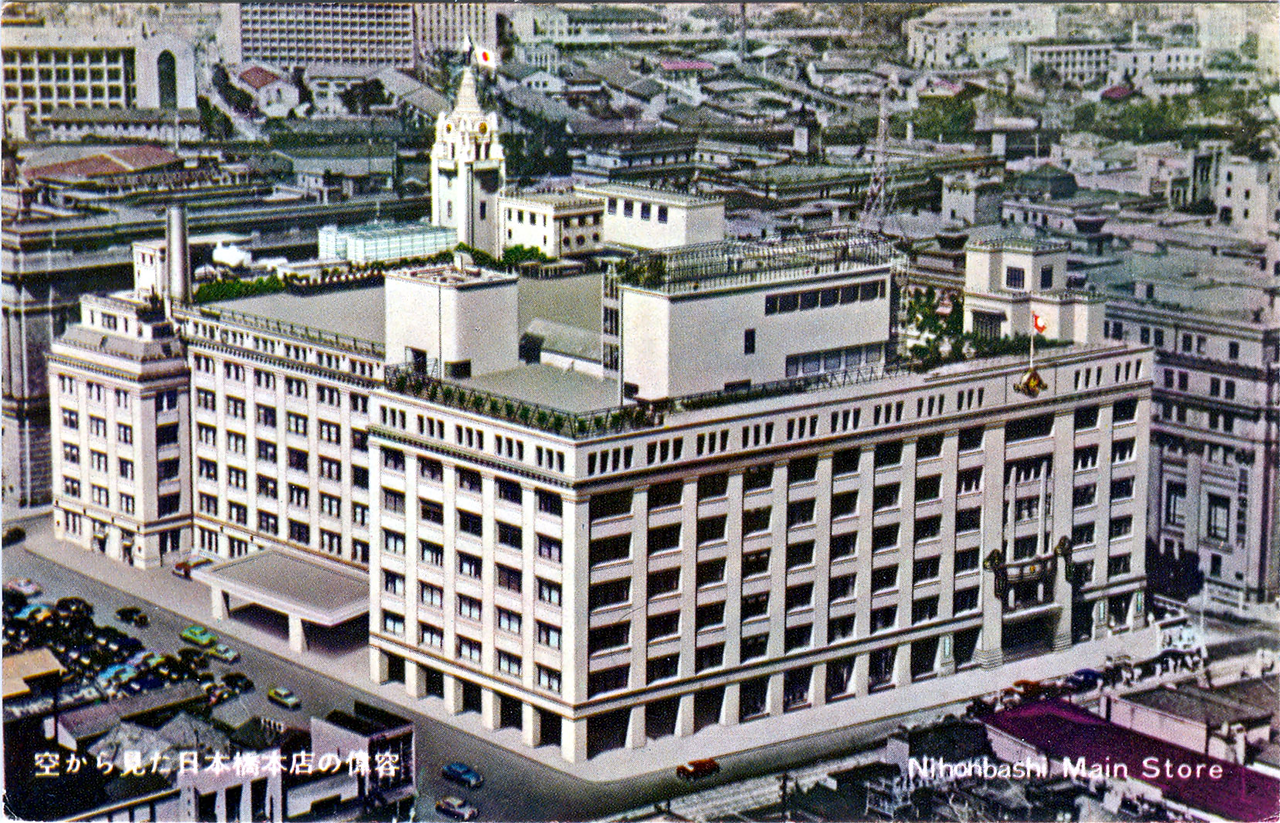
Aerial view of the Mitsukoshi department store in Nihonbashi, Tokyo , where the introduction of the Canonet took place (1950)
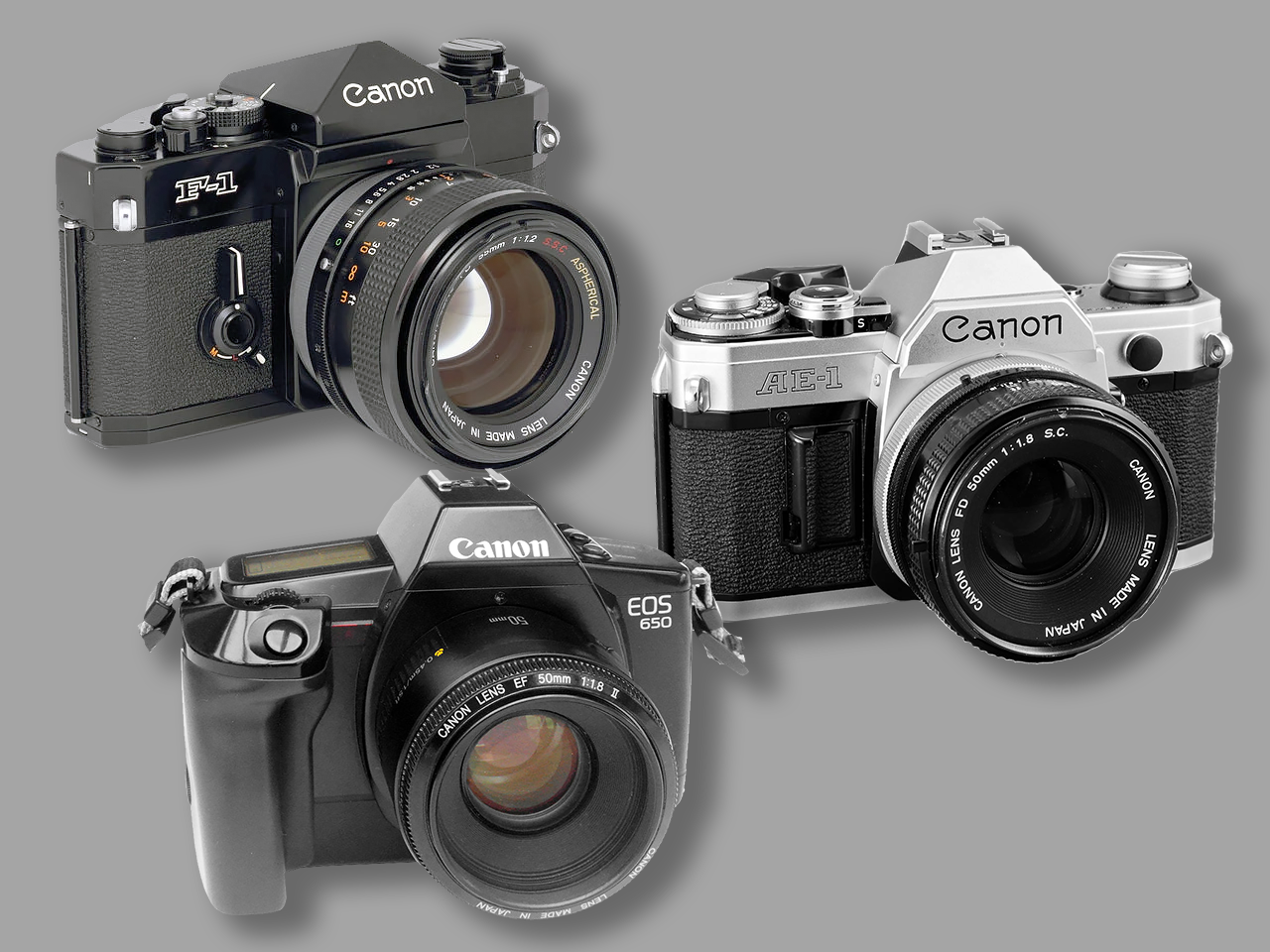
Depicted are the F-1, a top-of-the-line 35mm SLR camera introduced in 1971, the AE-1, introduced in 1976, which was the world’s first SLR camera equipped with a built-in microcomputer. In 1987 Canon launched EOS, the world’s first AF (autofocus) SLR camera to employ a fully electronic mount system.
In 1959, Canon introduced its first single-lens reflex (SLR) camera, the Canonflex, followed in 1961 by the Canonet, an immensely popular rangefinder camera that took the market by storm with the slogan “anyone can buy it and anyone can take pictures with it.”
Although the plan was to market the “Canonet” camera in August l960, its debut was delayed until January l961 because of strong criticism from the competitors complaining that the price of under 20,000 yen was too low to compete with.
When the camera was introduced for the first time at the display and sales counter on the 7th floor of Mitsukoshi department store in Nihonbashi, Tokyo, the number of people interested in seeing the camera was so great that they overflowed onto the staircases.
The total inventory for one week was gone within 2 hours after the sales counter opened. Its sales were so astronomical and its customer acceptance so overwhelming that the February 6, 1961 issue of Shukan Bunshun (a popular weekly magazine) covered the sensation in the article entitled “Go to Hell!! Canonet.”
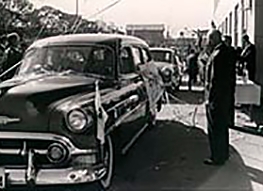
The first domestic shipment of “Canonet” cameras leave the Shimomaruko plant
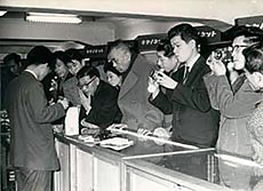
“Canonet” display and sales counter on the 7th floor of Mitsukoshi Department Store
Following these successes, the Company continued to lead the industry with a range of popular camera models, such as the F-1, a top-of-the-line 35mm SLR camera introduced in 1971, and the AE-1, introduced in 1976, which was the world’s first SLR camera equipped with a built-in microcomputer. In 1987, following continued technological innovation, Canon launched EOS, named after the goddess of the dawn, the world’s first AF (autofocus) SLR camera to employ a fully electronic mount system.
In 1995, EOS marked its entry into the digital era and the line-up continues evolving today. In 1996 Canon introduced a pocket-sized digital camera with the Advanced Photo System, named ELPH in America and IXUS in Europe. Canon entered the digital video camcorder market in 1997.
Canon has been manufacturing and distributing digital cameras since 1984, starting with the RC-701. The RC series was followed by the PowerShot and Digital IXUS series of digital cameras.
In 2012, the Company released the Cinema EOS System, a line-up of professional digital cinematography cameras and lenses realised through the culmination of various technological innovations centred on optical technologies developed since the Company’s founding. Since its introduction, the Cinema EOS System has contributed to expanding the horizons of visual expression.
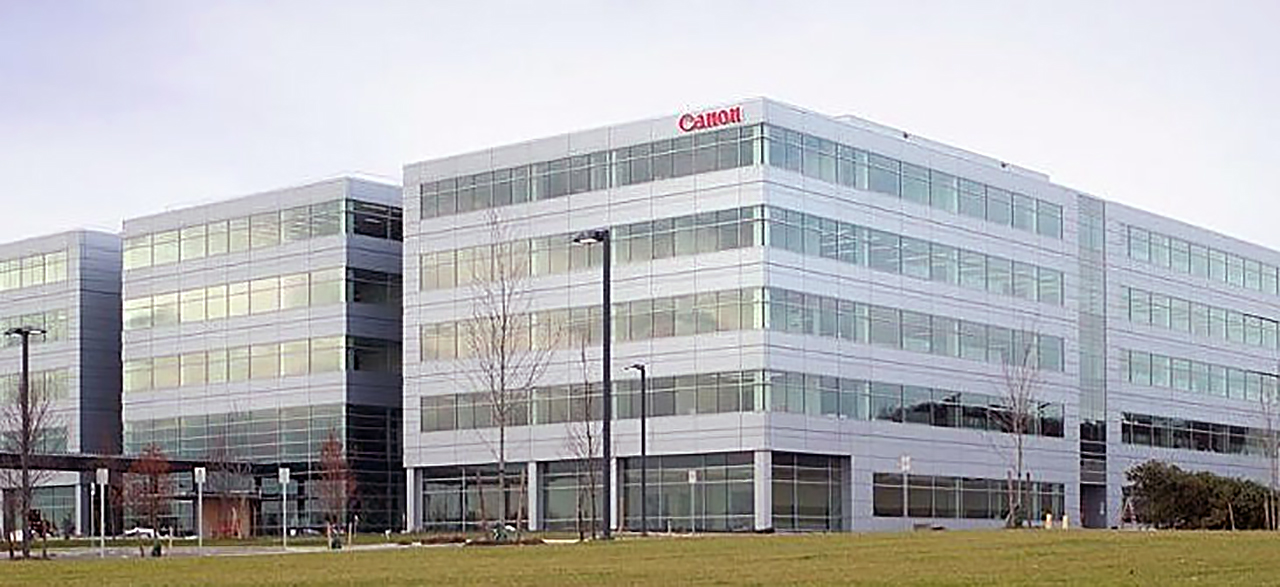
Canon’s HQ is home to approximately 6,000 staff responsible for R&D, management, sales and marketing. It covers a large area and several buildings. Inside the walls of these buildings engineers are probably busy working on the next generation (and the one after that) PowerShot and DSLR digital cameras.
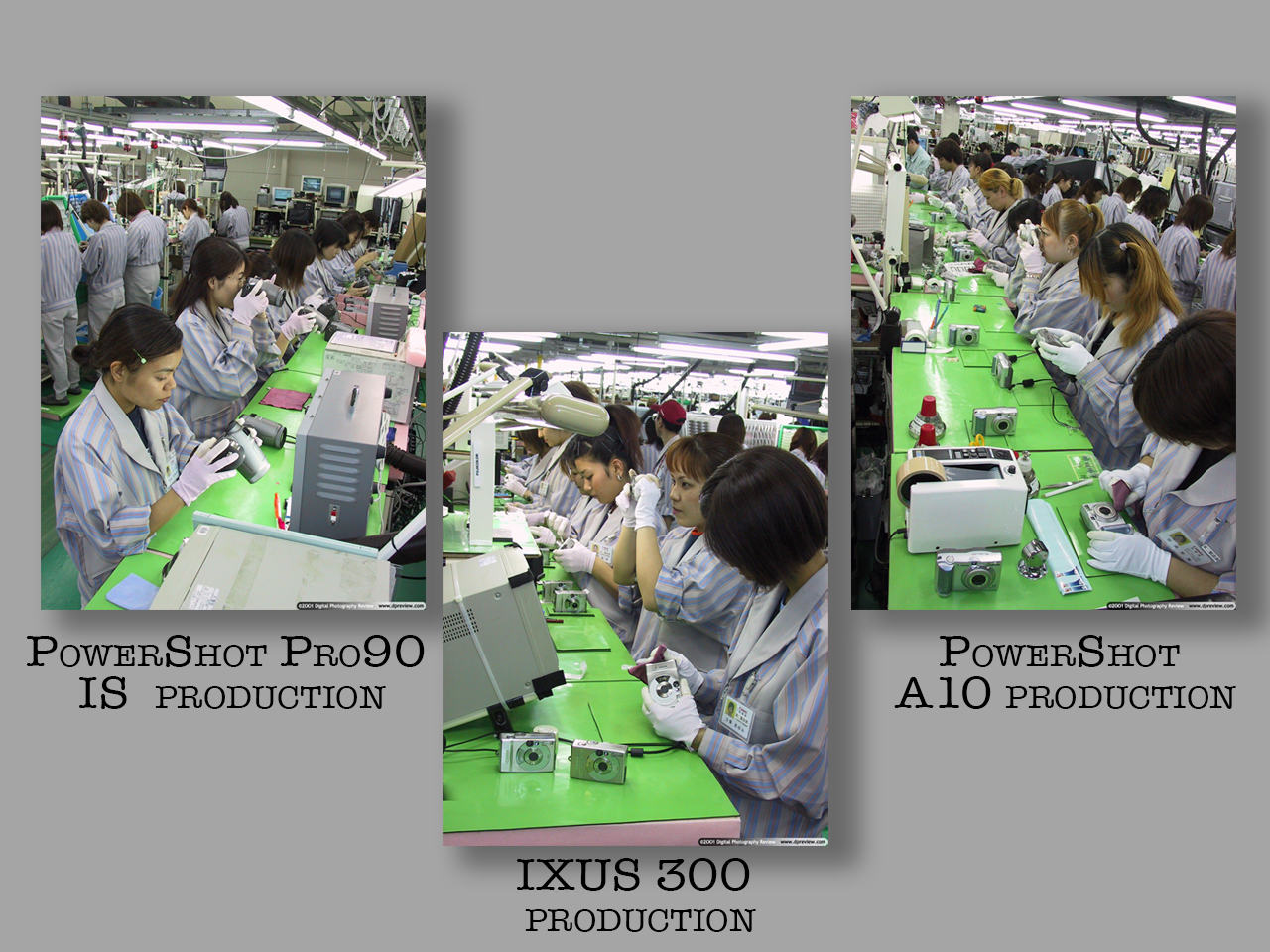
Next we took a tour of the factory itself. Seeing first the production of the IXUS 300 and IXUS v models then A10/A20 and finally SLR’s, including the EOS-D30 which is produced by a cell along side Canon’s other high end 35mm SLR’s. Unfortunately we weren’t allowed to take any photographs of the inside of the factory or the production line. The images above were provided by Canon shortly after the visit.
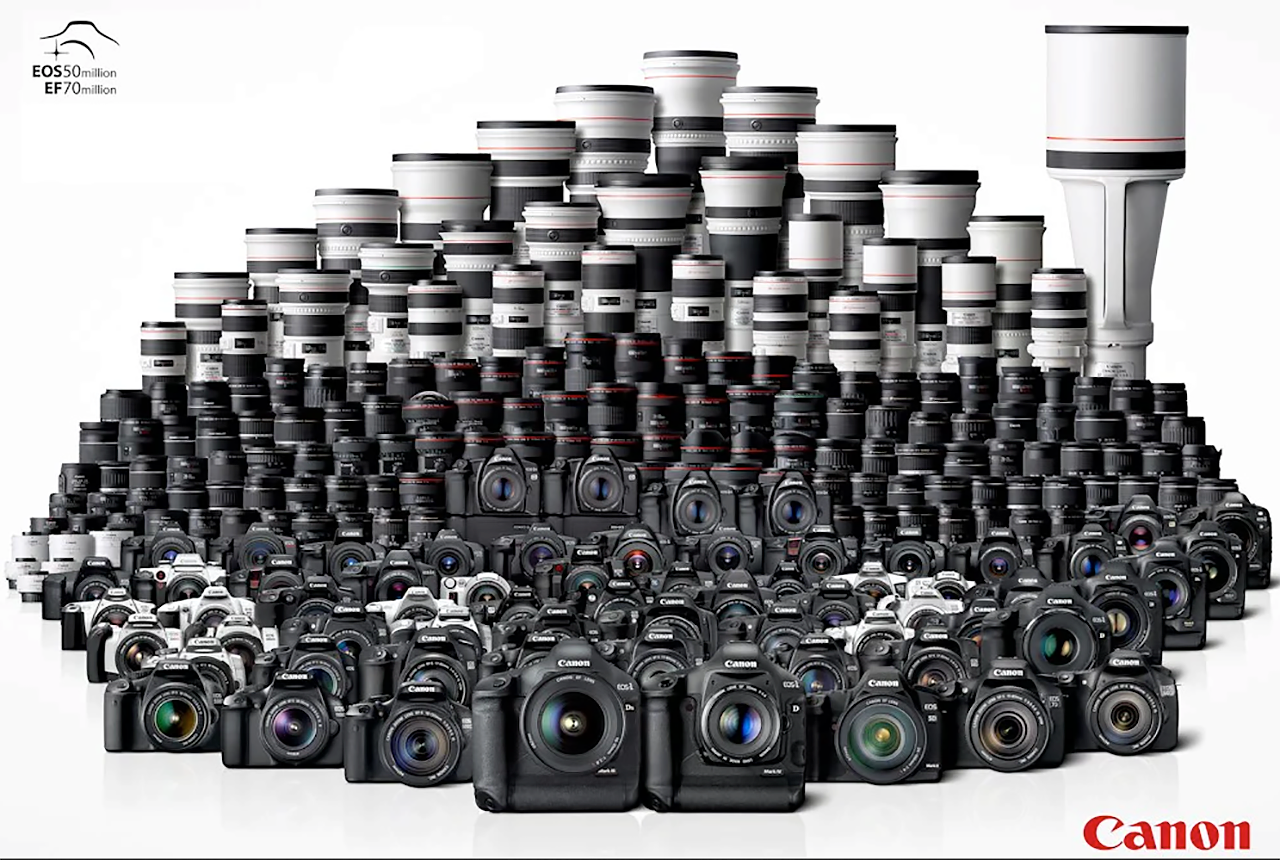
Canon Celebrates 50 Million EOS-Series SLR Camera & 70 Million EF Lens Production Milestones in May 2019
Production of the EOS SLR camera first began in 1987 at Canon Inc.’s Fukushima Plant (now Fukushima Canon Inc.), and then later moved to Oita Canon Inc.; Canon Inc. Taiwan; and most recently Nagasaki Canon Inc. from March of 2010. In 1997, the 10th anniversary of the series, production reached 10 million units, and in 2003 passed the 20-million mark. After the rapid spread of digital SLR cameras, Canon went on to reach the 30-million mark during the series’ 20-year anniversary in December 2007 and the 40-million mark in May 2010, followed by the current 50-million-unit production milestone, attained after a short one year and four months.
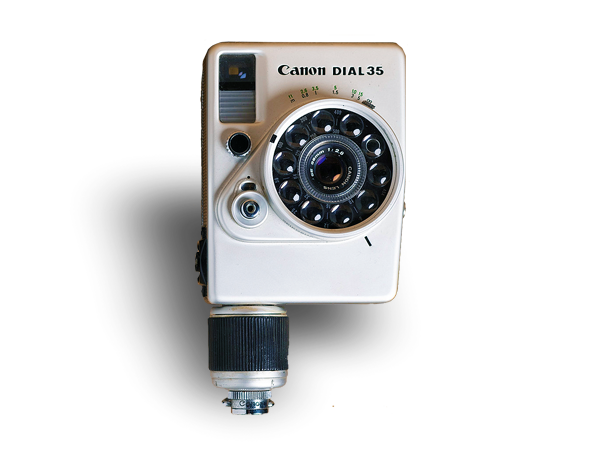
The Canon Dial 35 is an unconventional half-frame 35mm camera with clockwork automatic film advance. It was made in Japan from November 1963. The Dial 35 was also sold as the Bell & Howell Dial 35.
film cameras
I am aware that the Canon history I gave here is very brief. Much of the information I obtained from the site of the Canon Museum. This site goes much deeper into the different types of cameras, lenses, etc. Therefore, if you really want to know everything about Canon’s history, I advise you to go to this site. The link is:
https://global.canon/en/c-museum/index.html#history-hall
Still I will give you here a chronological list of film cameras as manufactured between 1934 and 2005. The list is based on the information as obtained from the site of the Canon Museum.
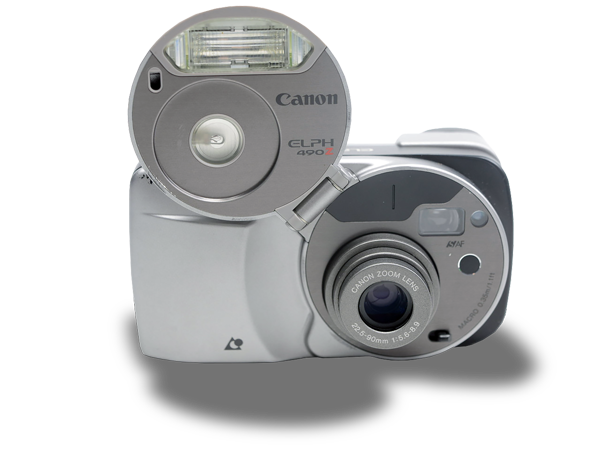
The Canon ELPH 490Z is a compact APS camera, similar to the Canon IXUS APS cameras, introduced in July 1996. It has a circular lens cover, which hinges up to open, and houses the main flashgun and a smaller lamp for red eye reduction.
(1934 – 2005)
- KWANON (Prototype) (1934)
- Hansa Canon (Standard Model) (1936)
- J (Popular Model) (1939)
- JS (Popular Model with Slow Speeds) (1939)
- J II (1946)
- NS (New Standard Model) (1939)
- S (Newest Model) (1939)
- S (1946)
- S II (1946)
- II B (1949)
- II C (1950)
- II A (1952)
- II D (1952)
- II D’ (1952)
- II AF (1953)
- II AX (1953)
- II F (1953)
- II S (1954)
- II S2 (1955)
- II D2 (1955)
- II F2 (1955)
- III (1951)
- III A (1951)
- IV (1951)
- IV S (1952)
- IV Sb (1952)
- IV Sb2 (1954)
- VT (1956)
- VT Deluxe (1957)
- L1 (1957)
- L2 (1957)
- L3 (1957)
- VL (1958)
- VL2 (1958)
- VI T (1958)
- VI L (1958)
- P (Populaire) (1959)
- Canonflex (1959)
- Canonflex R2000 (1960)
- Canonflex RP (1960)
- Canonflex RM (1962)
- Canonet (1961)
- Canonet Junior (1963)
- Canonet S (1964)
- Canonet QL17 (1965)
- Canonet QL19 (1965)
- Canonet QL 25 (1965)
- Canonet QL 19E (1965)
- Canonet 28 (1968)
- New Canonet QL17/QL17-L (1969)
- New Canonet 28 (1971)
- New Canonet QL19 (1971)
- Canonet G-III 17 (1972)
- Canonet G-III 19 (1972)
- Canonex (1963)
- Demi (1963)
- Color Demi (1963)
- Demi S (1964)
- Demi C (1965)
- Demi Rapid (1965)
- Demi EE17 (1966)
- Demi EE28 (1967)
- Dial 35 (1963)
- Dial Rapid (1965)
- Dial 35-2 (1968)
- PELLIX (1965)
- PELLIX QL (1966)
- FX (1964)
- FP (1964)
- FTQL (1966)
- F-1 (1971)
- FTb (1971)
- F-1 High Speed Motor Drive Camera (1972)
- FTb-N (1973)
- F-1 (Later model) (1976)
- New F-1 (1981)
- New F-1 High Speed Motor Drive Camera (1984)
- Bell & Howell Autoload 340 (1966)
- Bell & Howell Auto 35 / 28 (1969)
- Bell & Howell Autoload 341 (1969)
- Bell & Howell Autoload 342 (1969)
- Canomatic C30 (1966)
- Canomatic M70 (1970)
- Canodate E (1970)
- Canodate E (Later model) (1973)
- TL (1968)
- TX (1975)
- TLb (1976)
- T50 (1983)
- T70 (1984)
- T80 (1985)
- T90 (1986)
- T60 (1990)
- EXEE (1969)
- EX AUTO (1972)
- EF (1973)
- EF-M (1991)
- Datematic (1974)
- 110ED (1975)
- 110E (1975)
- 110ED20 (1977)
- AE-1 (1976)
- AT-1 (1976)
- A35 Datelux (1977)
- A35F (1978)
- A-1 (1978)
- AV-1 (1979)
- AE-1 Program (1981)
- AL-1 (1982)
- AF 32 (1995)
- SNAPPY 50 (1982)
- SNAPPY 20 (1982)
- SNAPPY S (1985)
- AQUA SNAPPY (1986)
- SNAPPY EZ (1988)
- SNAPPY Q (1989)
- SNAPPY AF (1989)
- SNAPPY V (1989)
- SNAPPY LX (1992)
- SNAPPY EL (1992)
- SNAPPY CX (1993)
- SNAPPY LX/DATE (1994)
- NEW SNAPPY EL (1995)
- SNAPPY QT/Date (1997)
- SNAPPY LXII/Date (1998)
- MC/MC QD (1984)
- MC10 (1985)
- SPRINT/SPRINT QD (1985)
- PHOTURA (1990)
- PHOTURA 135 / CAPTION (1992)
- Autoboy Jet Canon Williams Version (1991)
- Autoboy A (Ace) XL (1993)
- Autoboy Luna XL (1999)
- LA 10 (1993)
- LA 20 (1994)
- SURE SHOT (1979)
- SUPER SURE SHOT (1981)
- (New) SURE SHOT/(New)
- SURE SHOT QD (1983)
- SURE SHOT SUPREME (1986)
- SURE SHOT TELE/TELE QD (1986)
- SURE SHOT MULTI TELE (1988)
- SURE SHOT ZOOM (1988)
- SURE SHOT ACE (1988)
- SURE SHOT JOY (1988)
- SURE SHOT ZOOM XL (1989)
- SURE SHOT CAPTION ZOOM (1989)
- SURE SHOT ZOOM S (1989)
- NEW SURE SHOT (1990)
- SURE SHOT MEGA ZOOM 105 (1991)
- SURE SHOT MEGA ZOOM 76 (1991)
- SURE SHOT TELE MAX (1991)
- SURE SHOT MAX (1991)
- SURE SHOT ZOOM MAX (1992)
- SURE SHOT Z115 (1993)
- SURE SHOT M (1993)
- SURE SHOT Z85 (1994)
- SURE SHOT Owl (1994)
- SURE SHOT A-1 (1994)
- SURE SHOT DELSOL (1995)
- SURE SHOT 60 ZOOM (1995)
- SURE SHOT Z70W/CAPTION (1995)
- SURE SHOT 70 ZOOM (1995)
- SURE SHOT 80 TELE (1995)
- SURE SHOT Z135 (1996)
- SURE SHOT SLEEK (1996)
- SURE SHOT Owl/Date (1997)
- SURE SHOT 105 ZOOM/DATE (1997)
- SURE SHOT Zoom 85/Date (1998)
- SURE SHOT Z115 Panorama Caption (1999)
- SURE SHOT Z135 Caption (1999)
- SURE SHOT CLASSIC 120/CAPTION (1999)
- SURE SHOT 76 ZOOM/Date (2000)
- SURE SHOT Z90W/CAPTION (2000)
- SURE SHOT OWL PF (2000)
- SURE SHOT BF/DATE (2000)
- SURE SHOT 105 ZOOM S/DATE (2001)
- SURE SHOT Z155 (2002)
- SURE SHOT 130u (2002)
- SURE SHOT 115u (2003)
- SURE SHOT 105u (2003)
- SURE SHOT 80u (2003)
- SURE SHOT BF-10 (Date) (2003)
- SURE SHOT 90u (2003)
- SURE SHOT AF-10 (Date) (2003)
- SURE SHOT 150u (2004)
- SURE SHOT Z180u (2004)
- SURE SHOT 130u II Date (2005)
- SURE SHOT 115u II Date (2005)
- SURE SHOT 90u II Date (2005)
- EOS 650 / EOS 650 QD (1987)
- EOS620 (1987)
- EOS750 QD (1988)
- EOS 850 / EOS 850 QD (1988)
- EOS 630 (1989)
- EOS-1 (1989)
- EOS-1 HS (1989)
- EOS RT (1989)
- EOS 10 S (1990)
- EOS700 (1990)
- EOS1000F QD (1990)
- EOS 10 Commemorative Kit for 60 Million Units (1991)
- EOS ELAN (1991)
- EOS REBEL SII QD (1992)
- EOS A2 / EOS A2E (1992)
- EOS REBEL XS (1993)
- EOS REBEL X (1993)
- EOS-1N (1994)
- EOS-1N HS (1994)
- EOS-1N DP (1994)
- EOS 5000/EOS 888(Asia) (1995)
- EOS-1N RS (1995)
- EOS ELAN II / EOS ELAN IIE (1995)
- EOS REBEL G (1996)
- EOS IX (1996)
- EOS IX Lite (1998)
- EOS-3 (1998)
- EOS 3000 / EOS 88 (Asia) (1999)
- EOS REBEL 2000/QD (1999)
- EOS-1V (2000)
- EOS ELAN 7E / 7 (2000)
- EOS Kiss III L (2001)EOS Rebel XS N DATE (2002)
- EOS Rebel Ti (2002)
- EOS REBEL K2 (2003)
- EOS ELAN 7NE / EOS ELAN 7N (2004)
- EOS REBEL T2 (2004)
- PRIMA SUPER 28V (1994)
- PRIMA SUPER 28N/CAPTION (1999)
- PRIMA ZOOM 65/DATE (2001)
- PRIMA ZOOM 60/QD (2001)
- PRIMA BF800 ZOOM (China, South America) (2002)
- ELPH (1996)
- ELPH 490Z (1996)
- ELPH 10 AF (1996)
- ELPH 10 (1996)
- ELPH 260Z (1997)
- ELPH Jr. (1997)
- ELPH LIMITED KIT (1997)
- ELPH 370Z (1998)
- ELPH LT (1998)
- ELPH 2 (1999)
- ELPH SPORT (1999)
- ELPH LT260 (2000)
- ELPH LT270 (2001)
- ELPH SHADES GLACIER (2002)
- ELPH Z3 (2002)
- ELPH SHADES SUNSHINE (2002)
- IXY GE (1997)
- IXUS AF/Date (1999)
- IXUS FF/Date (1999)

FOUNDING DATE: 1874 (1868)
FOUNDER: J.T. CHAPMAN
COMPANY NAMES:
1868: Payne & Chapman; 1874: J.T. Chapman; 1907: Chapman died and the business, now a limited company, was run by William Hughes; 1917: Chapman’s son, James Gardiner Chapman became Managing Director; 1920: Foxall & Chapman; 1928: taken over by a subsidiary of Kodak Ltd.; 1962 Josiah’s grandson E.H. Richards became Managing Director; 1968: The company merged with Frederick Foxall Limited to become Foxall & Chapman; 1981: Finally, it was sold to William Kenyon & Sons.
COMPANY ADDRESSES:
1874: 162 Deansgate, Manchester; 1883: the new Scottish Provident Buildings at 7 Albert Square, Manchester; 1965 moved to 62 King Street , Manchester.
J.T. Chapman Limited was a photographic chemist; a manufacturer of photographic apparatus and a camera manufacturer located in Manchester, England.
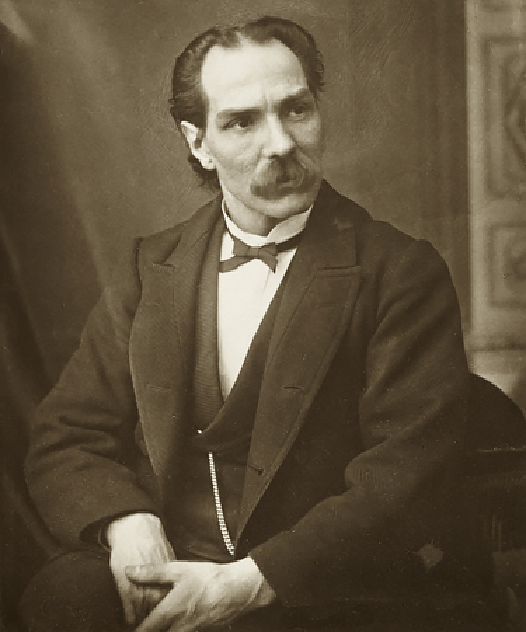
Josiah Thomas Chapman

Three boxes of Manchester gelatin dry plates.

The British folding camera was manufactured by J.T. Chapman in circa 1890. A collapsible field camera that was originally made in quarter plate and later also made in half plate sizes. The British folding camera was constructed of polished mahogany wood with brass fittings. The camera featured front and rear tilt, rear ground glass focusing and a double extension maroon leather bellows.
When describing J. T. Chapman’s photographic legacy, his son James Gardiner Chapman observed, “My father never grudged, or considered wasted, any time spent in helping a photographer – young or old; and it is to this more than anything else that I attribute his success and the success of the business.”
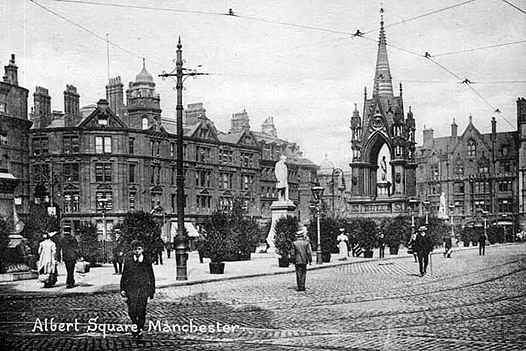
Josiah Thomas Chapman was born in Staverton in Wiltshire in 1843. He was sent to Manchester at age 14 to apprentice under his uncle, chemist and druggist Josiah Thomas Slugg. Mr. Slugg was also an amateur astronomer, and schooled his young apprentice on optics as well as chemical processes. When delivering his uncle’s telescope catalogs for illustrations, he developed important relationships with local photographers and wood engravers.
By 1865, Mr. Chapman had successfully completed his apprenticeship and went to work for chemist and photographic supplier Robert Hampson, and was joined shortly thereafter by fellow chemist and photography enthusiast J. B. Payne.
When Mr. Hampson retired six years later, the business was promptly renamed Payne and Chapman. That same year, 1871, Mr. Chapman married Elizabeth Gardiner, with whom he would have six children.
The firm operated as dispensing chemists as well as dealing in photographic goods, the dispensing side of the business was later dropped allowing Chapman to concentrate on photographic items which included the manufacture of an early dry plate. A relationship developed with Joshua Billcliff, they jointly patented cameras and Billcliff cameras, such as the British, were sold under the Chapman name.
Within two years, his partnership with Mr. Payne ended, and the young entrepreneur decided to concentrate on his thriving photographic business. He began experimenting with Dr. R. C. Maddox’s dry plate formula, adding alcohol to his gelatino-bromide emulsion. His formula was used by Hurter & Driffield in their investigations on sensitometry because of its accurate standardisation. Chapman’s formula was published in 1873 in the British Journal of Photography. The Chapman dry plate was initially called the ‘Lancashire’ but was soon changed to the ‘Manchester’.
While dry plates were certainly advantageous, many photographers experienced difficulties determining exposure time and proper lens aperture. Chemists Ferdinand Hunt and Vero Driffield determined that Mr. Chapman’s Manchester plates produced the most impressive emulsion speed, and their published findings resulted in a dramatic surge in Manchester plate sales.
He designed his first camera, the quarter-plate Manchester, in 1883. Three years later, he introduced the amazingly popular British camera series, a sturdy basic camera that did not compromise quality for affordability. By the early twentieth century, the British camera was available in seven sizes.
Mr. Chapman’s burgeoning business quickly outgrew its modest Albert Square location, and he established photo development and printing shops nearby. Eventually, his entire establishment had to be moved to a larger facility on Brasenose Street.
T. Chapman died in 1907 in Manchester, Lancashire, England at age 63. However, is business was alive and well, first operated by Mr. Chapman’s assistant William Hughes before overtaken by his son James Gardiner Chapman in 1917.
By the 1920s, the company, which continued to develop photographs, built works at Old Trafford for developing and printing. Chapman was known primarily as a leading chemical and equipment supplier. In 1928 they were taken over by a subsidiary of Kodak Ltd, and in 1968 the company merged with Frederick Foxall Limited to become Foxall & Chapman.
In 1965, the business – now operated by grandson Edward Chapman – was moved to 62 King Street, and three years later, a merger with Frederick Foxall Limited necessitated a name change to Foxall & Chapman. Finally, in 1981, it was sold to William Kenyon & Sons.
The Chapman-information is largely drawn from the ‘Early Photography’ website. More detailed information is available on the ‘Historic Camera’ website, including the fact that in 1871 Chapman married Elizabeth Gardiner. He began experimenting with photographic emulsions, leading to the production of plates branded ‘Lancashire’ and ‘Manchester’. The published findings of independent tests (by Ferdinand Hunt and Vero Driffield) led to a surge in sales of ‘Manchester’ plates. In 1883 Chapman designed a quarter-plate camera named ‘The Manchester’. In 1886 he introduced the ‘The British’ series of cameras.
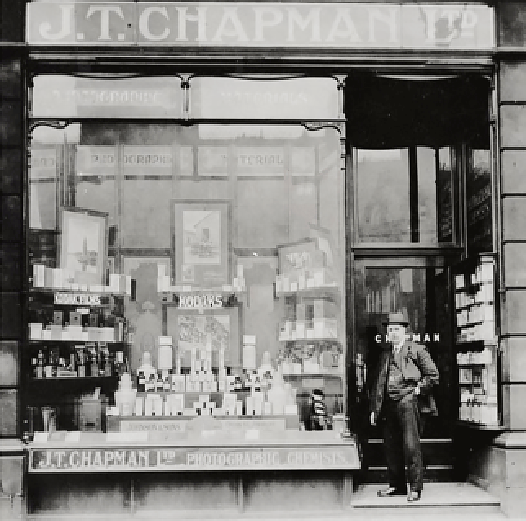
J.T. Chapman outside his shop.
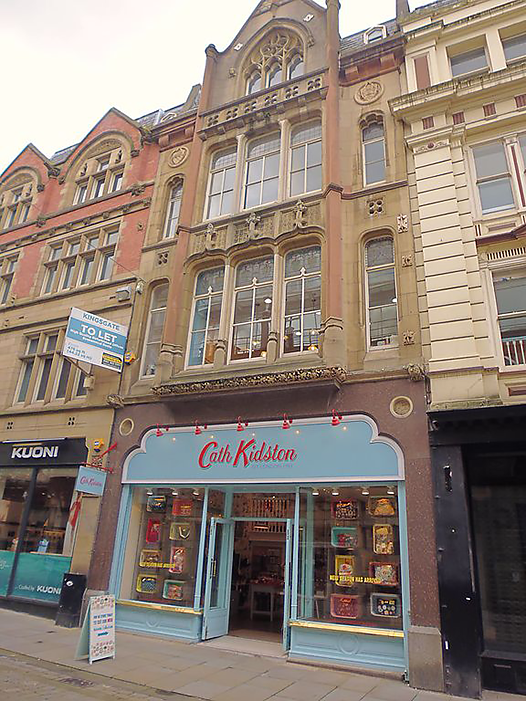
Cath. Kidston now has her shop where J.T. Chatman once was established; 62 King Street
- 1843 born in Staverton, Wiltshire
- 1858 Started working for his uncle, Josiah Thomas Slugg, a chemist and amateur astronomer, in Manchester.
- 1868 Left to work for Robert Hampson (previously the business of J.J. Payne at 63 Piccadilly, Manchester, a chemist who supplied photographic goods. Later, Chapman and a fellow employee took over the business to form Payne & Chapman.
- 1871 Chapman married Elizabeth Gardiner
- 1874 Partnership with J.B. Payne (trading as Payne & Chapman) was dissolved. Business of J. T. Chapman established.
- In 1883 Chapman designed a quarter-plate camera named ‘The Manchester’.
- In 1886 he introduced the ‘The British’ series of cameras.
- 1907 Chapman died.
Chapman and Joshua Billcliff jointly patented cameras, sold under the Chapman name. Cameras sold by Chapman sometimes carry the maker’s name, examples being: “Made by J.L. Lane & Sons for J.T. Chapman” and “Lejeune & Perken made for J.T. Chapman”. Another has the label “The Artists Tailboard made for J.T. Chapman 168 Deansgate”
- The British – detective magazine camera
- The British – ‘Miller’s Patent’ box camera
- The British – folding camera
- The British – stereo camera
- The Manifold – camera
- The Manifold – stereo camera
INVOLVED COMPANIES:
In the 30s Utility Manufacturing Co. 40 West 25th Street, New York City; in the 40s Monarck/Monarch 711 West Lake Street, Chicago; 1946 Spartus Corp. 711 (or 715) West Lake Street, Chicago; Galter Products Co. 715 West Lake Street, Chicago; 1956 Herold Products Company 715 West Lake Street, Chicago; Mid 50s Herold Products Company 2110 West Walnut, Chicago.
LOCATIONS OF THE CHICAGO COMPANIES:
Originally (1930s) 40 West 25th Street, New York City; in 1940 711 (or 715) West Lake Street, Chicago; Mid 50s 2110 West Walnut, Chicago.
Those who appreciate and collect vintage bakelite cameras frequently make two curious discoveries: First, a surprising number of simple plastic cameras seem to have originated from Chicago, Illinois, USA. And second, when compared closely, a number of these models (ostensibly coming from different manufacturers) have body styles which look practically identical.
In fact, several of these brand names can be linked directly to one particular address: 711 – 715 West Lake Street, Chicago, as noted in period advertisements or the manuals included with cameras. But even where the address is unknown, it seems quite clear that many of the Chicago camera models emerged from exactly the same set of moulds, casting doubt on the supposed separate identities of their makers.
This is an effort to consolidate this bewildering swarm of brand and model names into a single page: and to cross-reference body styles with alleged company names, using examples that have been observed on Flickr, eBay and elsewhere. In all cases, these are simple “snapshot” cameras, with the greatest variety being the many models for 127 film in the eye-level “minicam” style.
Many questions still require further research, but a few facts seem clear. Utility Manufacturing Co. originated several bakelite camera models under its brand Falcon in the 1930s. Utility gave its address as 40 West 25th Street, New York City. But certain camera models that were unquestionably made by Utility also appeared under other “company” names, the start of a practice that would explode in later years.
Already in 1940, cameras were being sold from 711 West Lake Street, Chicago by Monarck/Monarch (choose your spelling; the company used both). Many Monarch models have also been observed branded with names of other “manufacturers.”
Furthermore, by around 1946, Falcon models were reappearing branded as Spartus – or, if even still under the Utility/Falcon name, now marked as made in Chicago – with the Spartus home address given as 711 (or 715) West Lake Street. Confusingly, some early advertisements give Spencer as the company name behind Spartus brand cameras.
Spartus Corp. was a successful Chicago manufacturer of clocks and razors. It was owned by Jack Galter, onetime jazz drummer and serial entrepreneur. Beginning around 1939 he obtained several camera-related patents: One design patent is unmistakably that seen on numerous Chicago minicams (such as the Photo Master). A camera illustrated in another patent looks strikingly like the Monarck 127-film pseudo TLRs, while another is certainly the Falcon Rocket.
A Galter Products Co. also operated from 715 West Lake Street – including clocks and cameras in its offerings. In later years, Jack Galter accumulated significant real estate holdings, and became a major Chicago-area philanthropist.
In 1956 Spartus was sold to Harold Rubin, Spartus’ head of sales, who gave it the name Herold Products Company, Inc., but continued using the Spartus brand on clocks and cameras. And to tie this all into an impossible tangle, there is at least one printed manual for the Spartus Full-Vue which shows “Herold Manufacturing Co., not Incorporated” as the company, 715 West Lake as the address, whose cover shows a camera which is plainly labelled Galter Products under its taking lens.
Herold Products was in a death struggle with Eastman Kodak, who completely dominated the consumer photography market. They employed several interesting marketing techniques to try to steal market share from Kodak:
- they sold a complete outfit – Kodak often sold camera, film, flash attachment, bulbs, etc., as separate items;
- they very effectively imitated Kodak’s packaging – yellow, black and red colors and even similar fonts to those used by their competitors;
- they offered free film for one year after purchase, provided the owner used their development service, at a cost of $1.00 for “jumbo sized prints.”
In the mid-1950s Herold Products listed a different address, 2110 West Walnut, Chicago. And some of its later models are designs unique to them, ones which do not appear under other brands (for example the Spartus Co-Flash). By the 1960s Herold Products had reverted to Spartus as the company name, and it continued its clock production for many years (with later models showing Louisville, Mississippi as the company address).
It cannot be conclusively shown that all the camera brands listed here are products of the Falcon/Spartus/Herold group. Metropolitan Industries seems to have the most probable claim of true independent existence, with several unique models. But even they have suggestive overlaps with the Galter/Spartus brands (e.g. the “Cinex” name and the Clix De Luxe body style).
- Arco-Flash – Da-Brite (version 1) – Da-Brite (version 2)
- Flash Master – Herold “40” – Photo Master
- Spartacord – Sparta Fold V – Spartus 35
- Spartus 35F, Model 400 – Spartus 120 Flash – Spartus Co-Flash
- Sunbeam 120 – Sunbeam 127 – Sunbeam Six-Twenty
The appearance of the Chicago cameras under a plethora of different names was facilitated by printing all the camera’s identifying branding onto a single circular “donut” plate which was held to the front of the lens barrel by two screws. It is possible that the circular lens-shutter assemblies seen on so many of these cameras (with an instant/time selector at approximately the 4 o’clock position) were themselves provided by another subcontractor, and simply “bolted on” to moulded bodies from different shops.
The motivations for creating so many quasi-fictional brands can only be guessed at. Perhaps it was to offer certain distributors a brand that was exclusively theirs. Perhaps it was to avoid negative word-of-mouth over what were, after all, very basic cameras with rudimentary optics. In any case, the same approach would one day be adopted by Hong Kong’s manufacturers of cheapie cameras, giving us the many names of the Diana or the Bedfordflex.
Many of these cameras were designed to use 127 film, but in “half frames.” This was an economy measure first seen in depression-era cameras. The backing paper of 127 film has rows of frame numbers printed onto it; these align with red frame-counting windows on the back of the camera. But rather than exposing eight standard frames per roll, many of the “minicams” here would split each frame in half: Every frame number would be advanced first to one, then to the other red window. This yielded 16 exposures per roll (although it made the orientation of the rectangular frame vertical rather than horizontal). The resulting frame size is roughly 3 x 4 cm.
SEE ALSO THE ARTICLE ON CAMERA-WIKI
http://camera-wiki.org/wiki/The_Chicago_Cluster
(Followed by “company” names)
- Acro (Acro)
- Acro-Flash (Herold)
- Adams Miniature (Adams Camera Co.)
- Barry (Barry)
- Besta
- Beauta Miniature Candid multiple styles
- Brenda Starr Cub Reporter (Seymour)
- Burel
- Candex Junior (General Prods.)
- Candex Miniature (General Prods.) multiple styles
- Candid Flash Camera (Flash Camera Co.)
- Capitol
- Carlton Reflex (Allied)
- Champion (Camera Man)
- Churchill
- Cinéx (Craftsman, King, Spartus – also models from Cardinal and Imperial
multiple styles - Clix Deluxe (Metropolitan)
- Clix-O-Flex (Metropolitan) multiple styles
- Clix Master (Metropolitan
- Clix Miniature (Metropolitan)
- Clix Miniature Camera (General Prods.)
- Clix Supreme (Metropolitan)
- Color-Flex (Monroe, Photo Laboratories)
- Congress
- Da-Brite multiple styles
- Dasco
- Davy Crockett
- Dick Tracy (Seymour) multiple faceplates
- Drexel Junior (Drexel)
- Falcon Deluxe (Falcon)
- Falcon Deluxe Miniature (Falcon)
- Falcon Flash (Spencer)
- Falcon-Flex (Utility)
- Falcon Miniature (Falcon, Utility) multiple styles
- Falcon Minicam Junior (Falcon, Utility)
- Falcon Minicam Senior (Utility) metal and bakelite styles
- Falcon Minette (Falcon, Utility)
- Falcon-Abbey Electricamera (Utility)
- Falcon Press Flash (Utility)
- Falcon Rocket (Falcon)
- Faultless Miniature (Bernard)[14]
- Five Star Candid (Five Star)
- Flash-Master (Herold, Seymour)
- Fleetwood (Monarch)
- Flex-Master (Monarch) multiple styles
- Fowell Cinefilm
- Full-Vue (Spartus, Galter)
- Girl Scout Falcon (Utility)
- Hamilton Super-Flex
- Hopalong Cassidy (Galter) multiple styles
- Junior Photographer
- Kandō (Monarch)
- Kandō Reflex (Monarch)
- Keebler (A.C. Keebler Co.)
- Leecrest (Lee Industries)
- Lincoln (Monarch)
- Longchamp (Boumsell—France)
- Majestic (Monarch, Spencer)
- Mar-Crest (Mar-Crest)
- Marvette (Marvel Products)
- Metrocam (Metropolitan)
- Minix (Stan-Test)
- Minifoto Junior (Candid Camera Supply)
- Mirro-Flex (Metropolitan)
- Monarch (Monarch)
- Monarch 620 (Monarch)
- Monarck (Monarch) multiple styles
- Multi-Flex Mirro (North American)
- Namco Multi-Flex (North American)
- National Miniature (National Silver)
- Oxford Minicam Junior (H.E. Shaw)
- Packard Minicam (Packard)
- Photo Master multiple styles
- Photo Master Super 16 Twin 620 (Photo Master)
- Pickwik multiple styles
- Picta Twin 620 (Rolls)
- President (Camera Man)
- Raylee
- Regal (Galter)
- Regal Flash Master
- Regal Miniature multiple styles
- Remington (Deluxe Prods.) multiple styles
- Remington Miniature Camera multiple styles
- Renard Royce
- Rex (Utility)
- Rocket by Weimet (Weimet)
- Rolls (Rolls)
- Rolls Twin 620 (Rolls)
- Royal Reflex (Monarch)
- Silver King (Camera Man) multiple faceplates
- Spartus 127
- Spartus Full-Vue (Spartus, Galter)
- Spartus Miniature (Wholesale Photo Supply)
- Spartus Press Flash (Spartus, Galter) multiple faceplates
- Spartus Six Twenty multiple styles
- Sterling Miniature
- Sunbeam (Harold, or unlabeled) multiple styles
- Sunbeam 127
- Super Foto (Consolidated)
- Traveler (Monarch)
- Ultra-Vex
- Vogue (Monarch)
- Waldorf Minicam (Waldorf)
- Wit-Eez (Wittie)
List of company names
To be included here, a company must have offered at least one model that also appeared under a completely different “company” name. Most of the names in this list seem to have been pure marketing fictions. It is possible a few real, independent manufacturers have been inadvertently included here.
- A.C. Keebler Co.
- Acro Scientific Products Co.
- Adams Camera Co.
- Allied Camera Supply (=Utility)
- Altheimer and Baer Inc.
- Barry Products Co.
- Beauta*
- Bernard Products
- Boumsell (France)
- Burel & Co.
- The Camera Man
- Cinex*
- Consolidated Industries
- Craftsman Sales Co.
- Da-Brite*
- Drexel Camera Co.
- Elgin Laboratories
- Falcon Camera Co.
- Five Star Camera Co.
- Flash Camera Co.
- Fotax (Sweden)
- Galter Products Co.
- General Products Co.
- Hamilton*
- Herold Mfg. Co.
- King Sales Co.
- Lee Industries
- Mar-Crest Mfg. Corp.
- The March Corp.
- Majestic*
- Marvel Products
- Metropolitan Industries
- Monarch/Monark
- Monroe Sales
- National Silver
- North American Mfg. Co.
- Packard
- Photo Laboratories
- Photo Master*
- Pickwik*
- Raylee Industries, Inc.
- Remington*
- Renard Royce Corp.
- Rolls Camera Mfg. Co.
- Seymour Products Co. (Seymour Sales Co.; Seymore Products Co.)
- H. E. Shaw & Co
- Spartus Camera Corp.
- Spencer Co.
- Stan-Test Corp.
- Sterling*
- Sunbeam*
- Utility Mfg. Co. (New York, then Chicago; many models straddle both cities)
- Waldorf Camera Co.
- Weimet Photo Products (New York)
- Wholesale Photo Supply
- Wittie Mfg. & Sales Co.
* might be read as company rather than model.
FOUNDER: Chino Hiroshi
COMPANY NAMES:
1948: Sanshin Seisakusho; 1962: Sanshin Optics Industrial Co. Ltd; 1973: Chinon Industries Inc.; 1997: Eastman Kodak Company became majority shareholder; 2004: merged into the Eastman Kodak group as Kodak Japan Limited; 2009: as Chinon Corporation
COMPANY ADDRESSES:
1948: Chino, Nagano Prefecture.
Chinon Industries Inc. (Chinon Kabushiki-gaisha) was a Japanese camera manufacturer. Kodak took a majority stake in the company in 1997, and made it a fully owned subsidiary of Kodak Japan in 2004. As a subsidiary, it continued to develop digital camera models.
Chinon Industries Inc. was established by Chino Hiroshi in September 1948 as a manufacturing and marketing company for optical products such as lens modules and 35mm and movie cameras.
The company was originally known as Sanshin Seisakusho. Its name changed in 1962 to Sanshin Optics Industrial Co. Ltd, finally becoming Chinon Industries Inc. in 1973. Long-time partner Eastman Kodak Company became Chinon Industries Inc.’s majority shareholder in 1997, and later merged Chinon Industries Inc. into the Eastman Kodak group as Kodak Japan Limited, the Japanese daughter company of Eastman Kodak Co.
It sold digital cameras to Kodak and provided assistance to Kodak Electronic Products (Shanghai), the manufacturer of its cameras. The takeover by Kodak took place in January and February 2004.
Chinon manufactured many cameras, such as the CG-5, which was one of the first cameras ever to use an Auto Focus lens, which had to be bought separately. These lenses are now rare. They were cumbersome and had two infra-red “eyes” on top.
Another popular camera was the CM-1, a basic, fully manual 35 mm SLR camera favoured by student amateur photographers because it was cheaper than the rival Pentax K-1000, but could use the same lenses and accessories.
The CM-1 was sold through discount retailers such as K-Mart during the 1980s and proved to be very durable and reliable. Chinon branded products were sold in the USA through K-Mart, in the UK and in the Netherlands through Dixons and in Germany through Foto Quelle.
Most of Chinon’s SLR cameras used the Pentax K-mount, which was promoted by Pentax as a universal mount and therefore Pentax allowed and even encouraged other manufacturers to utilize their mount. This helped to expand the range of lens offerings for both Chinon and Pentax cameras. Several Chinon SLRs used the Pentax 42mm screw mount for the lens. Examples being the Chinon CS and the wonderful Memotron which were sold through Dixons.
Chinon also was a manufacturer of CD-ROM drives, scanners, electronic pocket calculators, and floppy disk drives.
- 1948
Sanshin Seisakusho established as a maker of camera lens frames and lens barrels in the city of Chino, Nagano Prefecture. - 1953
Sanshin Seisakusho reorganized into a stock-holding company. - 1954
Head office transferred to the city of Suwa, Nagano Prefecture. - 1956
Manufacturing 8mm movie camera lenses begins. - 1959
Develops and manufactures world’s first 8mm zoom lens. - 1962
Manufactures and exports own-brand 8mm movie cameras to Europe and America. Company name changed to Sanshin Optics Industrial Co. Ltd. - 1971
Manufacturing of 35mm cameras begins.
- 1973
Company name changed to Chinon Industries, Inc. Stock listed on second section of the Tokyo Stock Exchange. - 1974
First in Japan to develop and manufacture a simultaneous sound recording 8mm movie camera. - 1979
Manufacturing video camera lenses begins. - 1981
First in Japan to develop a near-infrared auto focus system. - 1982
Enters the emerging information device field with the development and production of information storage devices. - 1983
Develops and markets world’s first twin programmed SLR camera. - 1985
Begins producing 35mm cameras for Eastman Kodak Company on an OEM basis.
- 1993
Begins supplying Kodak with digital cameras on an OEM basis. - 1997
Kodak becomes majority shareholder (50.1%). Chinon strengthens digital camera design and production operations. - 1998
Digital camera production surpasses 1 million units. - 2000
Digital camera production surpasses 3 million units. - 2002
Digital camera production surpasses 5 million units. - 2004
Chinon Industries Inc. becomes Kodak Japan Limited.

35mm SLR Cameras
- Chinon AM-3
- Chinon CA-4 / CA-4s
- Chinon CE Memotron
- Chinon CE II Memotron
- Chinon CE-3 Memotron
- Chinon CE-4
- Chinon CE-4s
- Chinon CE-5
- Chinon CG-5
- Chinon CM-1
- Chinon CM-3
- Chinon CM-4
- Chinon CM-4s
- Chinon CM-5
- Chinon CM-7
35mm Cameras
Power Winders
- Chinon PW 510
- Chinon PW 534/545
- Chinon PW 540
- Chinon PW 600/610
35mm Cameras
info back
- Chinon info back 2 (data back)
- Chinon info back 3 (Interval timer)
35mm SLR Cameras
CP range
The CP range was notable for models that could offer programmed autoexposure (with some limitations) using vanilla K-mount lenses. This is in contrast to Pentax and Ricoh who introduced proprietary KA & KR additions to the original mount to enable that feature.
- Chinon CP-5 / CP-5s
- Chinon CP-6
- Chinon CP-7m
- Chinon CP-9AF
- Chinon CP-X Program
- Chinon CS
- Chinon CS-4
- Chinon CX
- Chinon CX II
- Chinon DP-5 (variant of the CP-5)
- Chinon DSL
- Chinon Genesis (GS-7)
- Chinon Genesis II (GS-8)
- Chinon Genesis III
- Chinon Genesis IV
- Chinon LED Promaster (name variant of CM-1?)
- Chinon M-1
- Chinon SLR
- Chinonflex TTL
35mm Cameras
Point & Shoot
- Chinon 35 (35mm)
- Chinon 35EE (GAF Memo 35 EE) (35mm)
- Chinon 35F-A (35mm)
- Chinon 35F-EE
- Chinon 35F-M
- Chinon 35F-II
- Chinon 35FA II (35mm)
- Chinon 35FA Super (35mm)
- Chinon 35FS-A (35mm)
- Chinon 35FX-III (35mm)
- Chinon 35FX-IV (35mm)
- Chinon 35FX-Tm (35mm)
- Chinon AP600S / AP300 (APS)
- Chinon AP700S (APS)
- Chinon Auto 357Z (35mm)
- Chinon Auto 386Z (35mm, 38-60mm zoom)
- Chinon Auto 1001 (35mm)
- Chinon Auto 2001 (35mm)
- Chinon Auto 3001 (35mm)
- Chinon Auto 3301 (35mm, 35-70mm zoom)
- Chinon Auto 4001 (35mm, 35-70mm zoom)
- Chinon Auto 5501 / 6001 (35mm)
- Chinon Auto GL (35mm, fixed focus)
35mm Cameras
Point & Shoot
- Chinon Auto GL-II (35mm)
- Chinon Auto GL-AF (35mm)
- Chinon Auto GL-S (35mm)
- Chinon Auto GLX (35mm)
- Chinon Auto GLX Tele Date (35mm)
- Chinon Auto GX (35mm)
- Chinon Belami AF (35mm)
- Chinon Bellami (35mm)
- Chinon Flash II
- Chinon Handyzoom 5001 (35mm)
- Chinon InfraFocus 35F-MA (35mm)
- Chinon Micro 35 EF
- Chinon Monami
- Chinon Monami 35 FS
- Chinon Pocket 77 (110 film)
- Chinon Pocket Dual-AF-P (Minolta P-Twin)
- Chinon Pocket Zoom (35mm)
- Chinon Splash AF (35mm)
- Chinon Splash GX (35mm)
Digital Cameras
- Chinon ES-1000
- Chinon ES-3000
Super 8
Film Cameras
- 133 PXL Silent Camera
- 60 RXL Sound Camera
8 mm Movie
Projectors
- 3000GL Silent Projector
- SP-330 Sound Projector
Some Examples
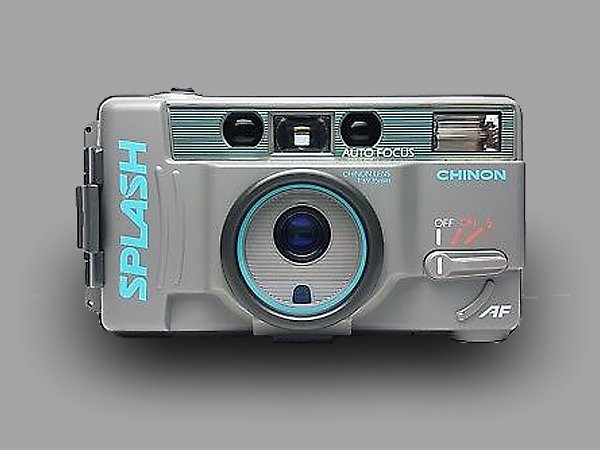
Chinon Splash AF is a weather-proof compact autofocus camera released in 1988. Foto-Quelle sold the Splash AF as Revue AW600.
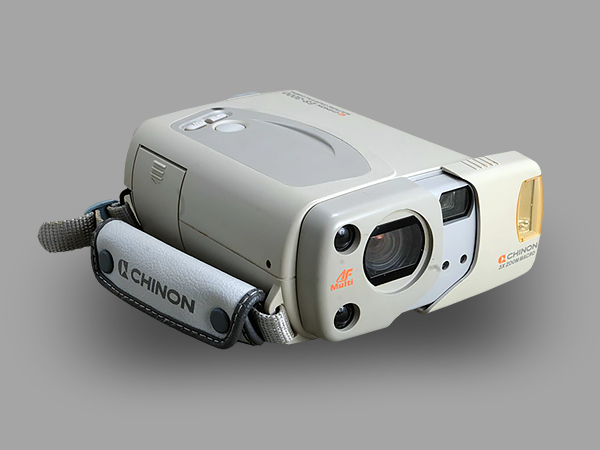
The Chinon ES-3000 is a digital still camera manufactured in 1995 and producing 640 x 480 pixel images.
Chinon Corporation has recently (2009) restarted by the founder’s family as the formal successor of CHINON and restarted its own marketing activities.
Currently (as of 2010) the Chinon Corporation produce digital cameras such as the Superheadz/Digital hedgehog retro 110 style toy camera and the Tachyon XC helmet camera.
They also produce film scanners and various other non camera related devices.
Mission of the new Chinon Corporation
The Chinon Corporation mission, which is enduring, declares our purpose as a company and serves as a standard to which we judge our actions:
- To provide technology that inspires, entertains and brings people together
- To anticipate and satisfy people’s desires and needs
- To bring about moments of optimism and happiness
- To create value and make a difference.

The Tachyon XC HD helmet camera.

Superheadz/Digital hedgehog 110 style toy camera.
COMPANY NAMES:
1984: Concord Camera in Rahway, New Jersey; 1998: moved its headquarters to Hollywood, Florida; 2009: the company ceased trading.
COMPANY ADDRESSES:
1984: Rahway, New Jersey; 1998: moved to Hollywood, Florida.
Concord Camera Corp. offered basic affordable low end cameras. These were produced in China which were branded under various names including Concord, Goldline, Keystone, Apex, Le Clic, Argus or Polaroid. It produced a range of both film and digital under its own brands (Concord Eye-Q) and for other companies. It also had some success producing single use cameras under it own and others marques.
Jack C. Benun started Concord Camera in Rahway, New Jersey, in 1982. He told the Wall Street Journal that he got his start in the business as a teenager when he resold pawn shop cameras out of a car on the streets of Manhattan. He claimed to later make $3 million as a minority partner in a Taiwanese camera business. Benun told Business Week that he made $1.8 million by the age of 30, decided to retire, but that within several weeks he was restless and returned to business by starting up Concord Camera.
He turned to the People’s Republic of China, which was beginning to open its doors to foreign businessmen, and in 1983 began operating a camera manufacturing plant in Baoan, 15 miles north of Hong Kong, where he had a design team in place. Skilled labour was both plentiful and cheap in China, allowing Benun to make cameras that were extremely price competitive. He concentrated on the low-end camera market, building cheap but reliable models. By 1988 Concord Camera was generating almost $20 million in annual sales, and Benun was looking to take the company public. What followed would begin a series of investigations and lawsuits that would haunt both Benun and Concord Camera well into a new century.
As a result of this unwanted publicity the price of Concord Camera stock lost almost a third of its value in one day. Nevertheless, Benun was cleared by his board, the company’s stock rebounded, and Concord Camera continued to grow.
Amid the turmoil of 1991, the company created a British subsidiary, as well as acquiring Keystone Camera for $6.6 million. It also entered the single-use camera business, which would become a company mainstay.
Concord Camera also was experiencing problems with its primary lender, Midlantic National Bank, after receiving a number of extensions on a deadline to repay a $15 million loan. The company found new funds when New York investor Ira J. Hechler provided some $3 million.
Despite its debt and posting a $2.7 million loss for fiscal 1992, Concord Camera was still looking to expand. It announced in September an agreement to purchase the Vivitar and Hanimex businesses from British competitor Gestetner Holdings PLC for $50.6 million.
Benun also announced that he would step down as CEO when the transaction was complete.
The Vivitar and Hanimex deal fell through, however, and Benun continued as CEO in 1993, as did the SEC investigation about him. Hechler, in the meantime, was purchasing more stock and gaining control of the company.
By July 1994 a confidential report was submitted, Benun was promptly fired, and the company then settled with the SEC. At Concord Camera Benun was replaced by Ira Lampert. He soon found himself the subject of criticism by Benun, and the company the subject of litigation.
Furthermore, Benun sued Concord Camera for $6.7 million over lost wages and benefits, claiming that he had been wrongfully terminated. The company then sued him, asking for damages of $2 million caused by ‘his frauds and embezzlements.’ Separately, disgruntled shareholders also sued Benun.
Early in 1995, with all the controversy surrounding the company, Concord Camera stock dropped to $2 a share. Lampert brought in a new management team that shed nonessential businesses to cut costs, bolstered its design staff, and began investing in technology. Concord Camera decided to concentrate on doing one category well, the single-use camera, and rely on its low-cost China facility to give it a competitive edge. It landed a deal with 3M to manufacture its single-use cameras and other companies soon followed.
Overall, the single-use camera category was experiencing robust growth. Concord Camera further capitalized on the trend by introducing a line of single-use cameras targeted at the under-12 market. Moreover, the outsourcing movement of the 1990s now extended to the camera industry, as both Kodak and Polaroid farmed out manufacturing work to Concord Camera and its low-cost China facilities.
The company’s commitment to research and development also was beginning to pay off. Its Keystone brand introduced a patented system that could automatically imprint on pictures such messages as ‘Happy Birthday,’ ‘Vacation Fun,’ and ‘Stay in Touch.’
In December 1998 Concord Camera moved its headquarters from New Jersey to Hollywood, Florida. Its business now had a solid footing. It was producing point and shoot cameras for its own labels, as well as supplying private label cameras to major retailers such as Wal-Mart, Kmart, and Sears. It was a major supplier of single-use cameras for its own labels and major camera makers as well as toymakers Fisher-Price and Crayola. It also was working with Hewlett-Packard to develop a digital camera, as well as developing a digital image-capture device that could transmit pictures to a cell phone. In effect, Concord Camera was transforming itself into a technology company.
By 1999 it generated $118.4 million in sales, after posting just $40 million four years earlier. A few months later it introduced its first digital camera, ‘eye Q,’ a low-cost product that it planned to sell on a private label basis to retailers and that industry analysts predicted would become a major success. It reached #20 in Fortune’s list of the fastest-growing companies and was listed #25 in Forbes 200 Best Small Companies.
The company, in the meantime, was experiencing continued growth, although poor earnings forecasts from Polaroid and Kodak had an adverse impact on Concord Camera stock. Prospects appeared promising, but Concord Camera faced competition in its outsourcing business from Asian competitors. Its move into high-tech products was also risky, as digital technology evolved far more rapidly than film.
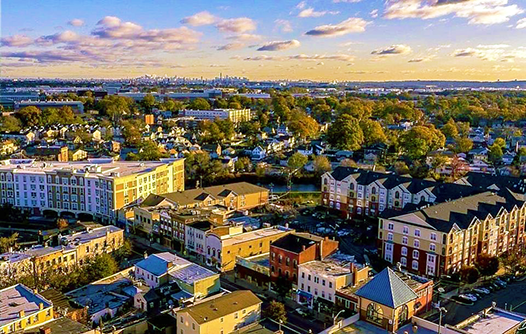
Aerial view of the City of Rahway, New Jersey.
Early in 1995, with all the controversy surrounding the company, Concord Camera stock dropped to $2 a share.
Keystone 35mm film, automatic camera, built-in flash c1997. Able to imprint 12 pre-defined messages onto the negative (i.e. “Happy Birthday,” “Thinking Of You”, etc).
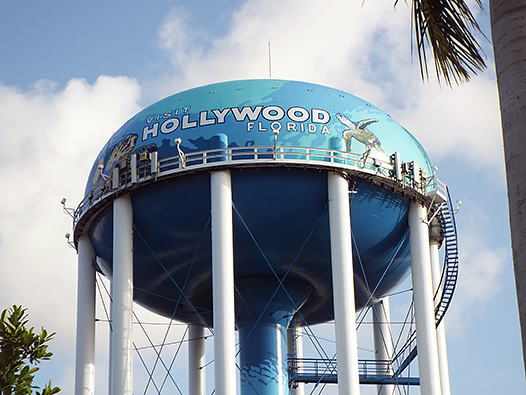
Water tank in Hollywood, Florida
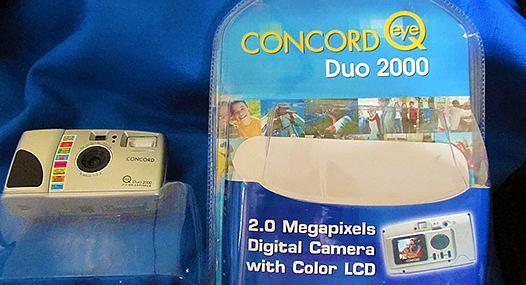
By 1999 Concord introduced its first digital camera, the eye Q.
Concord produced digital, 35mm, 110, and single use cameras. For example, the Concord 3045 camera is a 3.1 megapixel digital camera that was manufactured by Concord. It manufactured digital cameras mainly under its own Concord eye-Q range. Its single use and film cameras were sold under the Polaroid brand.
Concord also produced framing and photo storage solutions under its Frame and Store brand. This range included frames, photo CDs and negative storage solutions.
Concord sold its image capture products worldwide through sales and distribution offices in the United States, Canada, Germany, Japan, Hong Kong, the United Kingdom and France, as well as through independent sales agents.
They sold both branded and private label products to many of the largest retailers in the world, including Aldi, Argos, Boots, Carrefour, Comp USA, CVS, Dollar General, Eckerd, Family Dollar, Ito-Yokado, MetroAG, Rite Aid, Ritz Camera Shops, Target, Walgreens and Wal-Mart.
One of the latest developments of Concord was the OnGuard Kids Personal Safety Alert System. In a press release of 2007 Concord Camera Corp. announced that its OnGuard Kids Personal Safety Alert System is the recipient of a prestigious “Best Products Summer 2007 Award” from Dr. Toy’s Institute for Child Resources. This is the second award received by Concord for its OnGuard Kids system which was previously awarded the prestigious “Best Products of 2007 Award” from iParenting Media in the safety category.
The OnGuard Kids system was a complete personal safety alert system that combines a stylish digital watch with a powerful 110 decibel alarm and SOS signal that may be activated by children in emergency situations.
Also packaged with the watch are a child ID system and an educational DVD hosted by family safety expert Bob Stuber. In the DVD, Mr. Stuber teaches children how to use the watch to attract attention in an emergency and offers positive advice and proactive actions for children facing perilous situations.
Since the competition on the under 12 market was too big, as a result of which the expected turnover and profits failed to materialize, the shareholders agreed in 2009 to dissolve and liquidate the company, so Concord ceased trading in 2009.
List of Concord Cameras
- Concord 642
- Concord 1500
- Concord 3345
- Concord 3346z
- Concord 4042
- Concord 4340z
- Concord 5040
- Concord 5062AF
- Concord 5445z
- Concord 3046 (3.1 Mpix.)
- Concord 3047 (3.1 Mpix.)
- Concord DVx
- Concord ES510z (5.1 Mpix.)
- Concord ES500z
- Concord Eye-Q 1000
- Concord Eye-Q 1200x
- Concord Eye-Q 1300 (1.3 Mpix.)
- Concord Eye-Q 2040 (2 Mpix.)
- Concord Eye-Q 2133z
- Concord Eye-Q 3103
- Concord Eye-Q 3120 AF
- Concord Eye-Q 3132z
- Concord Eye-Q 3340z (3.2 Mpix.)
- Concord Eye-Q 3341z (3.1 Mpix.)
- Concord Eye-Q 3343z (3.1 Mpix.)
- Concord Eye-Q 4060AF
- Concord Eye-Q 4330z
- Concord Eye-Q 4342z
- Concord Eye-Q 4360z (4 Mpix.)
- Concord Eye-Q 4363z
- Concord Eye-Q 5062af
- Concord Eye-Q 5330z (5 Mpix.)
- Concord Eye-Q Duo (1.3 Mpix.)
- Concord Eye-Q Duo 2000 (2 Mpix.)
- Concord Eye-Q Go (1.3 Mpix.)
- Concord Eye-Q Go 2000
- Concord Eye-Q Go Wireless
- Concord Eye-Q Mini
- Concord 818
- Concord Auto Focus 990AF
- Concord AW900
- Concord AW905
- Concord AFF
- Concord CAM-II
- Crayola CR10
- Crayola CRD (custom face plate)
- Crayola CRT
- Concord L-3
- Le Clic 240 BV
- Le Clic 82SL
- Le Clic 470
- Le Clic C170 (also Le Clic 170)
- Le Clic B-View/Two Tone
- Le Clic Caption Camera 870PM
- Le Clic Easy Shot Camera 400
- Le Clic Easy Shot Camera 500
- Le Clic Easy View 640
- Le Clic Fun Shooter FS30
- Le Clic Fun Shooter FS40
- Le Clic Fun Shooter FS50
- Le Clic LC16 BV
- Le Clic LC17
- Le Clic LC17 CC
- Le Clic LC17 BV
- Le Clic LC25 BV
- Le Clic LC27 EV
- Le Clic LC37 BV
- Le Clic Tuff35
- Le Clic Tuff underwater
- Polaroid 170BV
- Polaroid Splash
- Polaroid Splash II (2004)

- Concord 110CEF
- Concord 110CEFT
- Concord 110EF
- Concord 110TEF
- Concord 118
- Crayola Mini 110 Camera
- Crayola Flash
- M&M Smiles
- Genesis II
- Le Clic 308 Everflash
- Le Clic FS10 Everflash
- Le Clic Le Mini
- Le Clic Pocket 110
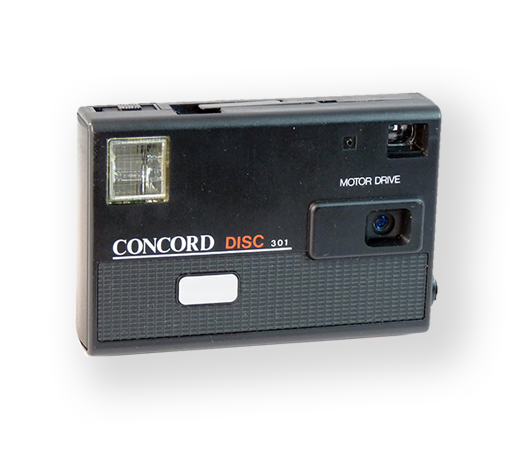
- Concord Disc 101
- Concord Disc 301
- Concord Disc 401
- Concord Disc 1001
- Concord Disc 4001
- Le Clic Disc
- Le Clic LC100
- Le Clic LC150
- Polaroid Fun Shooter Flash
- Polaroid Fun Shooter Waterproof
Concord Principal Subsidiaries:
- Concord-Keystone Sales Corp.;
- Concord Camera Gmbh;
- Concord Camera France S.A.R.L.;
- Concord Camera HK Limited;
- Concord Camera (Europe) Limited;
- Goldline (Europe) Limited.
Brands:
The Concord Camera Corp. manufactured products under the following brands before it ceased trading;
- Accomplishments
- Concord
- Concord Eye-Q
- Polaroid
- Fun Shooter
- On Guard Kids
- Frame and Store
- Easyshot
- Jenoptik
In 2004, Concord acquired Jenimage Europe GmbH, related to Jenoptik, and licensed the right to use the Jenoptik trademark for 20 years. It produced a range of compact digital cameras under the Jenoptik brand.
CONCORD TIME LINE:
- 1982: The company is founded by Jack C. Benun in Rahway, New Jersey.
- 1983: Benun founded a factory in Bao’an in the the People’s Republic of China.
- 1988: The company goes public.
- 1990: The company acquires Argus & Safari from Optex, inc
- 1991: The company created a British subsidiary.
- 1991: The company acquires Keystone Camera.
- 1994: Founder and CEO Jack C. Benun is terminated for cause.
- 1998: Headquarters is moved to Hollywood, Florida.
- 2004: The company acquires Jenimage GmbH from Jenoptik’s former digicam distributor 4MBO.
- 2009: The shareholders agreed to dissolve and liquidate the company.
- 2009: The company ceased trading.
The On-Guard complete alert system for Kids should become Concord’s last resort. The system was already elected as “Best Products of 2007 Award” from iParenting Media in the safety category.
FOUNDING DATE: 1959
FOUNDERS: KENNETH & JOHN CORFIELD
COMPANY NAMES:
1949 – 1960: K. G. Corfield Limited; 1959: K.G. Corfield; Camera production ended around 1962/63. 1960: K.G. Corfield (Sales) Ltd.; 1961: K.G. Corfield (Sales) Ltd. The company ceased trading in 1971.
COMPANY ADDRESSES:
1949 – 1960: Merridale Works, Wolverhampton; 1959: Ballymoney, N. Ireland;
1960: 33 Newman St., London; 1961: 1 – 3 Charlotte St., London W1.
K. G. Corfield Limited was a British camera maker from the 1950s and 1960s. The company produced high quality cameras and lenses basing many design features on the Leica range of 35mm cameras. One unique design was employed in the Periflex series of cameras in the 1950s which utilised a novel periscope viewing system to achieve fine focus. They also made the rare Corfield 66.
The Corfield company started just after WWII by two brothers (Kenneth and John) as a small family company, initially in their own home in Wolverhampton! Corfield started out as a company by making photographic accessories before they moved into producing cameras.
Their first product was an enlarger exposure meter, the Lumimeter, an exposure meter for use in the darkroom based on the comparison between reflected light from the enlarger and a variable transmitted light from the meter observed in a split screen. When both sides were equally lit, the dial controlling the variable light showed the correct exposure.

Where it all began. Sir Kenneth’s old house in Lonsdale Road.

The driving force behind the company was Sir Kenneth George Corfield.
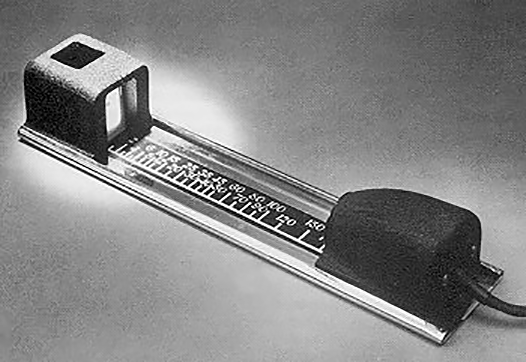
The Lumimeter
The next step was a handheld rangefinder, the Telemeter and an extinction exposure meter. They were well-built and well-finished products, even though they may be perceived cumbersome today.
The success of the accessories and the profits that came with it gave Corfield the confidence to branch out into the camera business itself.
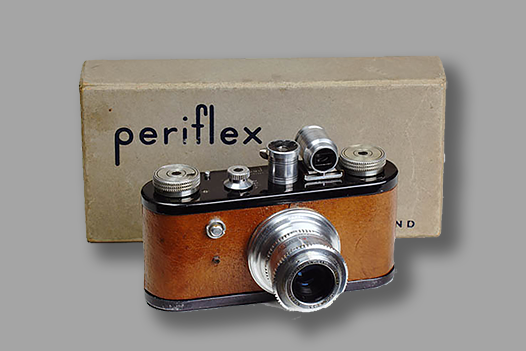
Very first version of the Periflex in black enamel with pigskin cover and Lumar 50mm f/3.5 lens, shown here with its rather plain original box. The pigskin cover stained easily and therefore Corfield soon decided to use black leather instead.
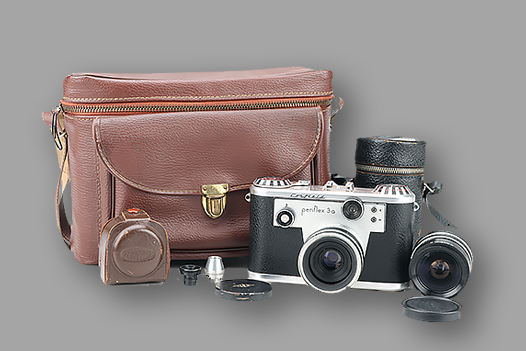
One of the last models as produced: the Periflex 3a.
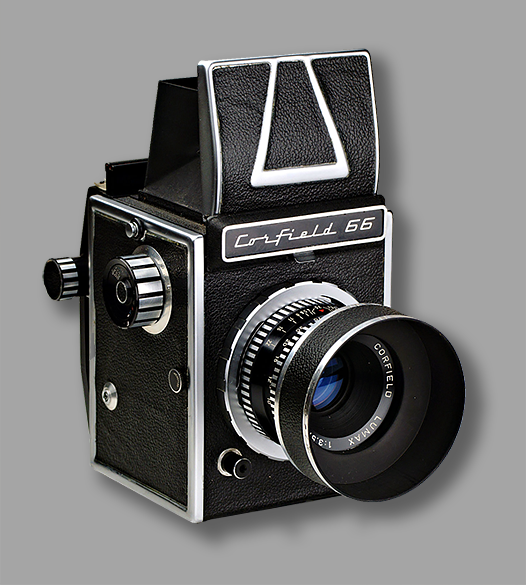
A Corfield 66 with its standard four-element Lumax 95mm f/3.5 lens and dedicated lens hood.
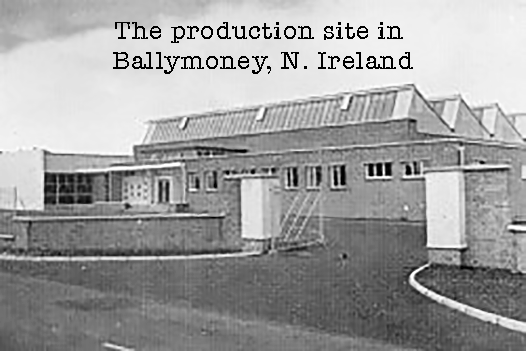
The talent of the Corfield brothers for design and marketing let to the development of their first high quality camera, the 35mm Periflex. It employs a 1/30 to 1/1000 sec. and B focal plane shutter and it has the standard 39mm Leica screw mount. This compatibility with the Leica was a genius move as it allowed people to use the many accessories that were made for that system and were easily available.
The body and removable back are metal castings, while the top and base plates are of stamped black anodised aluminium with delicate engravings. One unique design was employed in the Periflex series of cameras which utilised a novel periscope viewing system to achieve fine focus. A miniature periscope descended into the optical path of the lens when the film was advanced. This provided a much enlarged view of the central area of the film frame. When the shutter was released, the periscope sprung vertically up out of the optical path and then the horizontal cloth focal plane shutter operated.
The company’s final camera, the Corfield 66, was introduced in 1961 and was quite a change from what it had done before, a medium format SLR camera not dissimilar to the Hasselblad 500C and Fujita 66 also around at the time. It was a well-constructed camera without any fancy features, presumably in an attempt to keep the price down (e.g., the fold-up leather viewing hood), but it put the money where it was needed. It had an instant return mirror and was flash synchronised although the synchronisation speed was a slowish 1/15s.
The driving force behind the company and its products was Sir Kenneth Corfield. In January 1959, the camera manufacturer moved from Wolverhampton to Ballymoney, becoming the only camera manufacturers on the island of Ireland. In the face of face of Japanese and German competition, the enterprise failed. The company ceased trading in 1971. Subsequently, Sir Kenneth Corfield resurrected the firm later to build the Architect camera and to become involved in the production of Gandolfi cameras.
K.G. Corfield Camera Listing
- Periflex (silver)
- Periflex 2
- Periflex 3a
- Periflex 3b (black)
- Periflex Gold Star
- Periflex Interplan
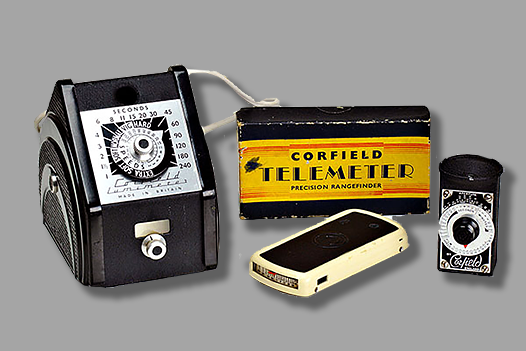
Corfield Lumimeter II, Telemeter (with its box) and Optical Exposure meter.
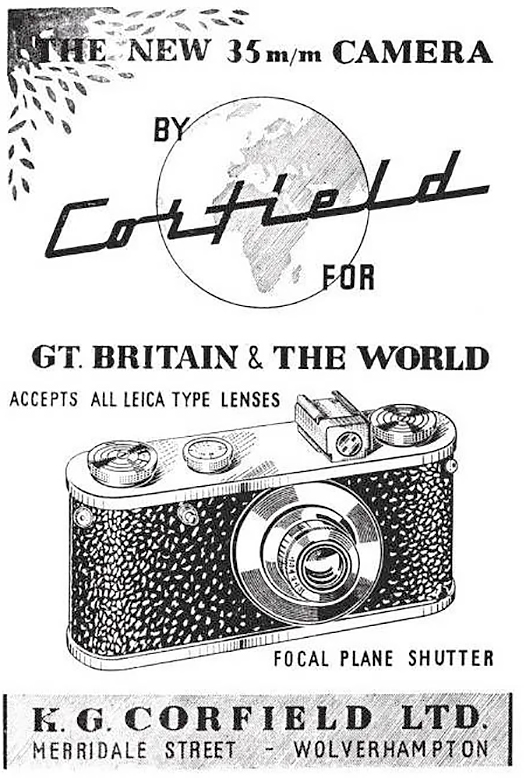
This January 1953 advertisement announced a new Corfield camera for Great Britain and the World. Notice the drawing lacks the periscopic viewfinder.
Further Information: Photographica World no. 71 has an article from a talk given by Sir Kenneth Corfield in which he covers the development of the company. For a detailed history of Corfield see John E. Lewis’ book – Corfield Cameras. A History & Collectors’ Guide
FOUNDER: Frederick W. Pettifer
COMPANY NAMES:
1926: The Coronet Camera Company; 1946: Coronet Ltd.; 1967: the company ceased operations.
COMPANY ADDRESSES:
1926: 48 Great Hampton Street, Aston, Borough of Birmingham, West Midlands, England; 1946: 308-310 Summer Lane, Aston, Birmingham.
The company set out to manufacture an inexpensive line of box and folding cameras. Various marketing methods were explored including repacking of similar cameras and distributed via premium schemes or mail order catalogues. Over 50 different types of Coronet cameras exist. Standard Cameras Ltd. traded between 1931-1955. The factory building in Aston still stands.
In 1926 The Coronet Camera Company was established at 48 Great Hampton Street, Aston, Borough of Birmingham, West Midlands, England by Mr. Frederick W. Pettifer. The company set out to manufacture an inexpensive line of box and folding cameras. Various marketing methods were explored including repacking of similar cameras and distributed via premium schemes or mail order catalogues.
In the 1930s the company engaged the British Optical Lens Co. for lenses. In that time the Coronet Camera Company was adjacent to Elliott’s Victoria Works (Summer Lane) and the owner, Mr S J Pettifer, was a friend of Edwin Elliott. Elliott’s did some sub-contracting of body mouldings and lenses for Coronet cameras, including the Midget and the Vogue. Coronet made the metal parts and shutters and marketed the cameras under their name.
By 1933 it was recorded that 510,000 cameras were sold. Also during this time frame, the Coronet Co. either had a relationship with the newly formed Standard Cameras Ltd. company located at 51 Mott Street.
The Standard Cameras Ltd. company purchased the same plastic camera bodies and parts from Edwin Elliot’s plastics firm. Standard Cameras Ltd. sold a cheap box camera named Conway which took 6x9cm images on 120 film very similar to the Coronet Ambassador. The Standard Camera Ltd Co. went out of business in 1955.
Most of Coronet’s pre-war box cameras and post 1945 plastic moulded cameras appear with different nameplates and lens panel styles.
The main works were destroyed by bombing in the war. In 1946 the company formed a limited partnership and the name changed to Coronet Ltd. During this period the company was located at 308-310 Summer Lane, Aston, Birmingham. The company continued to produce cameras until 1967.
After World War II ended, the company specialized in low cost plastic bakelite camera’s. Also due to import restrictions imposed by the French Government, Coronet partnered with Tiranty of Paris to manufacture and sell existing and new models with parts from Birmingham and lenses from Tiranty, similar to scheme that the Eastman Kodak Co. used to avoid the restrictions. These cameras usually have ‘Made in France’, some with Boyer lenses, and French instructions on controls and include the models, Rapide, Le Polo, Weekend and Fildia.
In 1964 Coronet introduced a Coromatic camera, which could use the Kodak cartridge system
In 1967 the company ceased operations. Over the forty-one years of operations the Coronet Camera Company produced thousands of low priced cameras, which most are still commonly found today. Throughout its life the firm produced various Coronet accessories, flash units, close up filters and viewers and its own black & white Coronet Panchromatic film in 120 and 127 sizes, including Corochrome.
Close links exist between Coronet, Standard Cameras Ltd. and Conway Cameras with moulds and body parts being interchangeable, however the complete extent of this link is not known.
Over 50 different types of Coronet cameras exist. Standard Cameras Ltd. traded between 1931-1955. The factory building in Aston still stands.
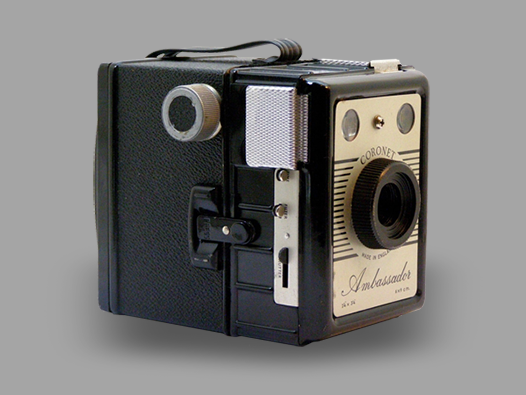
The Coronet Ambassador box camera, taking 6 x 9 cm pictures on 120 film, was produced from about 1955.
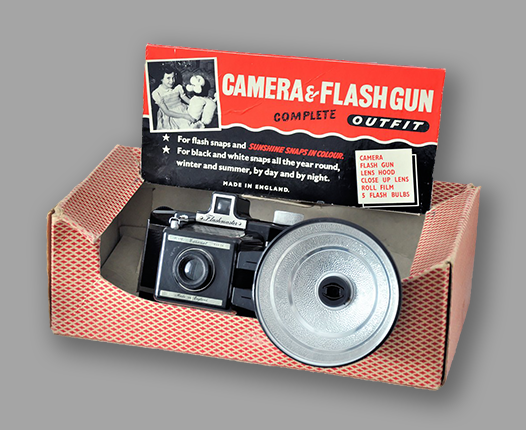
The Coronet Flashmaster takes 12 6 x 6 cm pictures on 120 film
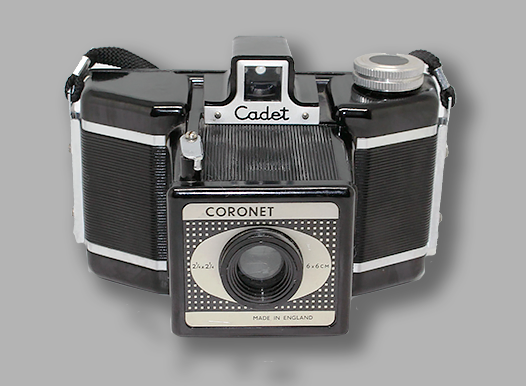
The Coronet Cadet is similar to the Coronet Flashmaster, but without flash synchronisation.
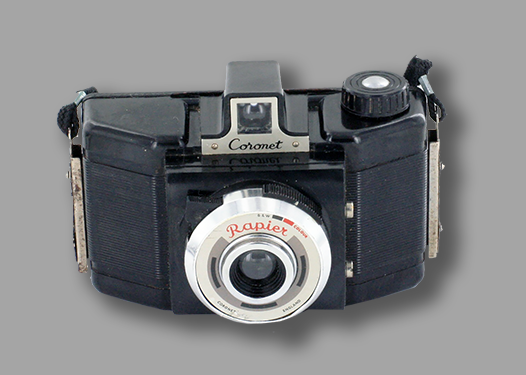
The Coronet Rapier is based on the Coronet Consul

The Coronet Victor is designed to take 4 x 4 cm pictures on 127 film
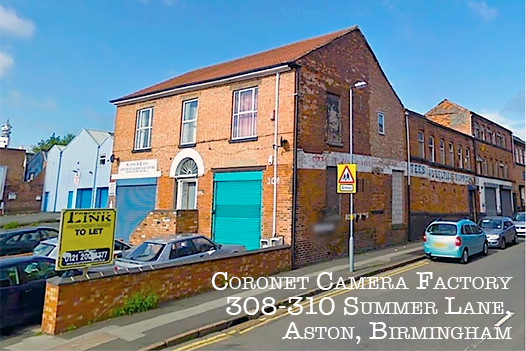
Attention to some of the Coronet products
The Coronet Ambassador
The Coronet Ambassador was produced from about 1955. It is a box camera, taking 6 x 9 cm pictures on 120 film. The back is attached to the front by snap fasteners, which allow the whole back to be removed for easy film loading.
The brilliant finders have hinged chromed covers which both protect the finder when not in use and also give a degree of shade when the finder is in use. There is a built in green filter. The Ambassador is not flash synchronised and in 1955 this camera cost £1 10s. 9d. The synchronised version, the Conway, was £1 13s. 2d.
The Coronet Flashmaster
Another common Coronet camera is the Coronet Flashmaster. This is a conventionally styled camera with a black bakelite body, ornamented with metal bands. It takes 12 6 x 6 cm. pictures on 120 film.
The Coronet Cadet is similar to the Coronet Flashmaster, but without flash synchronisation. In 1959, the Cadet cost £1 5s. 4d. and the Flashmaster cost £1 9s. 3d.
The Coronet Rapier
The Coronet Rapier is based on the Coronet Consul but has a 4 x 4 cm mask inside, thus taking 16 pictures on 120 roll film. It has a single speed shutter with flash synchronisation for the Coro-Flash unit.
There are two apertures, one for colour and one for black-and-white film. Colour film at this time was markedly slower than black-and-white. The Rapier was £1 14s. 1d. in 1959.
The Coronet Victor
The Coronet Victor is designed to take 4 x 4 cm pictures on 127 film. It has a two-speed shutter (1/30 and 1/100 second) with flash synchronisation and two apertures (f/11 and f/16). The Coronet Victor cost £2 12s. 8d. in 1959
Another common type of Coronet camera is the “reflex“. These have a large, brilliant reflecting finder as the viewing lens and a simple fixed-focus taking lens and are in no way in the same category of camera as a twin-lens reflex camera like the Rolleicord or Microcord.
The Coro-Flash
The 12-20 and similar F-20 Coro-Flash cameras take 6 x 6 cm pictures on 120 or 620 film. They have simple Time/Instantaneous shutters, three-point focusing lens and a built-in green filter. The F-20 has flash synchronisation. In 1953 the 12-20 cost £2 0s. 5d. and the F-20 was £2 5s. 1d.

The Coronet Midget is a tiny box camera made of Bakelite. It is only 6.5 cm long and 2.6cm wide, and weighs in at a mere 71g. It was introduced c.1935, in several colours – black, lime green, olive green, brown, red/black mottled and rose/orange mottled, and later in blue (1937). The camera was available in a number of design variations. It is the most sought after camera that was made by Coronet.
It took six 13x18mm exposures on 16mm paper-backed rollfilm, using a simple Taylor-Hobson f10 fixed-focus meniscus lens and a 1/30s fixed-speed shutter. The rear of the camera hinges downward for film loading. A red window centred in the back is used to control film advance, wound by either a plain knob or a hinged D-shaped loop.

The Midget sold for 5s/6d (£0.275) in Britain in 1935, and $2.85 (including delivery) in the US in 1939. These cameras were also made available through premium schemes.

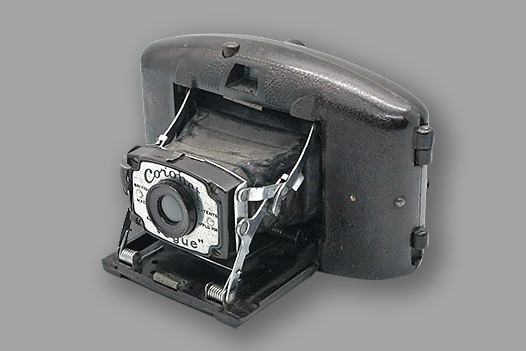
The Coronet Vogue; one of the first models Coronet made.
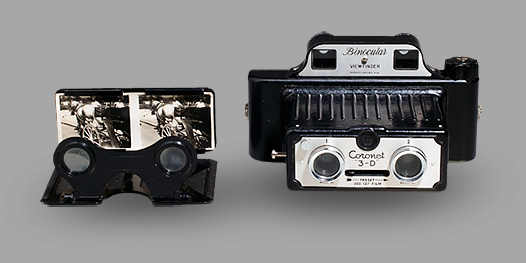
The “3-D” from Coronet is a stereo camera for taking pairs of photos on 127 film.Here it is complete with a corresponding stereo viewer
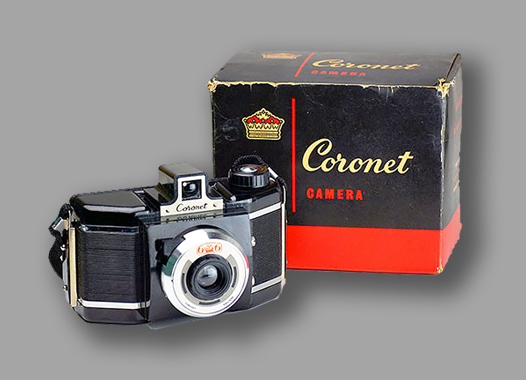
The Coronet 6-6 is a simple point-and-shoot Bakelite-bodied camera from the 1950s, using 120 medium format roll film, taking twelve 6x6cm images.
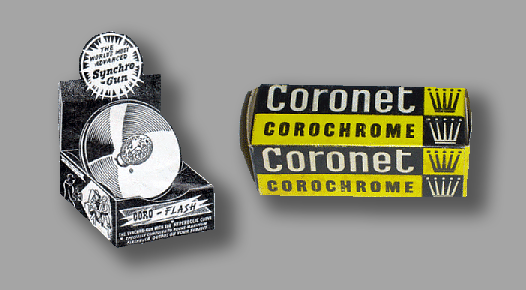
The Coro-Flash and the Coronet Corochrome film.
Coronet Cameras Listing
- Ajax
- Alliance
- Ambassador
- B20 Box
- BOBOX
- Box Camera no. 1
- Box Portrait Lens no. 2
- Box Eclair
- Cadet
- Cameo
- Captain
- Clipper
- Comet
- Commander 2
- Consul
- Coromatic
- Coronet Conway
- Coronet 3D stereo
- Coronet 4×4
- Coronet 4×4 Mark II
- Coronet 6×6
- Coronet 020 Box
- Coronet Folding
- Coronet Folding Pocket
- Coronet Folding Rollfilm
- Coronet Folding Rollfilm (Special colored version)
- Coronet Plate Box Camera
- Crown
- Cub
- D20
- Diadem
- Dynamic
- Eclair Lux
- Every Distance
- Every Distance 16
- F-20 Coro-flash
- Fildia box
- Flash Master
- Le Polo
- Midget
- Modernist
- Outspan
- Photo-Box
- Popular Twelve
- Rapide
- Rapier
- Rapier Mark II
- Rex Box (France)
- Rex Box early (England)
- Rex Box (England)
- Rex Flash
- Rex Folding
- Rex Snapshot
- Super-Flash
- Supreme Deluxe
- Three-Five
- Toni-Box
- Twelve-20 Coro-flash
- Varsity Box
- Victor
- Viscount
- Vogue
- Xcel
FOUNDER: Bunjirō Kobayashi
COMPANY NAMES:
1959: Nikō (or Nikoh); 1973: Cosina Co.,Ltd.
COMPANY ADDRESSES:
1959: Nakano, Nagano Prefecture, Japan.
Though the company has produced cameras and lenses under its own name, it is better known for making equipment for resale under other company’s brand names. Cosina has manufactured camera bodies for many well-known camera brands, including Canon, Contax, Nikon, Revue, Olympus, Vivitar, Voigtländer, Yashica and Zeiss Ikon.
Cosina Company, Ltd. is a Japanese camera and lens manufacturer based in Nakano, Nagano Prefecture, Japan. The company was founded by Mr. Bunjirō Kobayashi in February 1959 as a lens processing factory under the name Nikō (or Nikoh). Nikō was a pioneer in optical polishing and lens grinding in Japan.
In 1966, it also started to manufacture 35 mm compact cameras and 8 mm cine cameras, and a year later started the manufacture of 35mm film SLR cameras; in 1968 it started a glass melting factory.
Nikō changed its name to Cosina Company Ltd. in 1973. (The first part of the name is a reference to the Koshi area within Nakano, where the founder came from; while the ‘Na’ represents Nakano.)
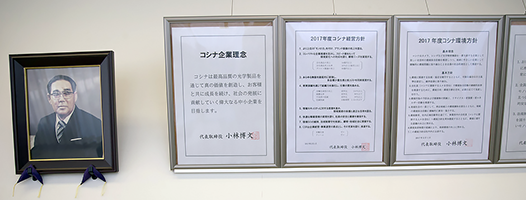
The portrait of Cosina’s founder hangs in the meeting room of one of the firm’s factories.
Cosina has a long history of manufacturing optical glass and is currently capable of producing glass and plastic aspheric lenses. The factory maintains a glass furnace that is heated to 1300 oC, running 24 hours a day.
All glass produced by Cosina today is lead-free eco-glass. Their current glass polishing technology is able to achieve sub-micron precision. They also have vacuum-deposition optical coating capabilities that are certified to meet Carl Zeiss lens standards.
In 1982, Cosina began to manufacture lenses in a variety of SLR manufacturers’ lens mounts. In 1991, it started to produce glass moulded aspheric lenses, and in 1996 plastic moulded a-spherical lenses.
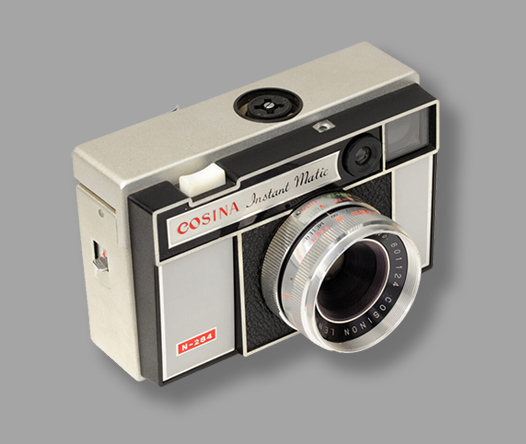
Cosina Instant Matic N-284 (the company’s first complete camera for 126 film)
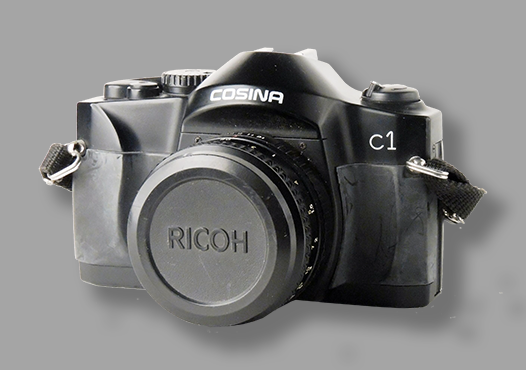
Cosina C1 35mm Camera + 55mm f2.2 Riconar Lens
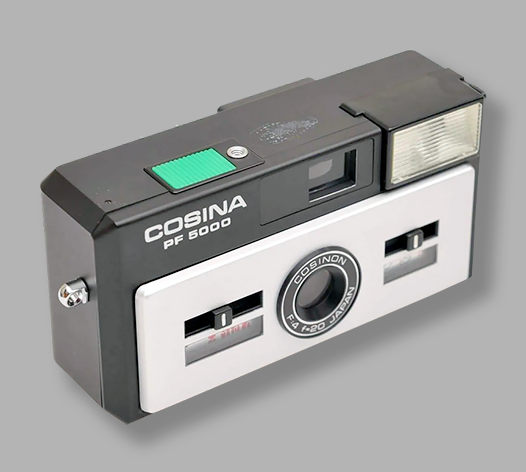
This tiny retro Cosina PF 5000 uses 110 film.
Cosina and Voigtländer
In 1999, Cosina secured partial rights to the German, once Austrian, classic camera brand “Voigtländer”, acquired from Ringfoto GmbH & Co. Alfo Marketing KG in Germany, to produce the Classic Collection (high-quality lenses with both M39 screw thread and Leica M bayonet, 35mm film cameras Bessa R, Bessa L, Bessa T, and medium format cameras Bessa III).
Cosina first introduced the Voigtländer 15 mm f/4.5 and 25 mm f/4 lens (neither of them rangefinder-coupled) and the Voigtländer Bessa-L standard camera body. It quickly followed with a wider range of Voigtländer cameras (starting with the Bessa-R, with viewfinder and rangefinder, and the Bessa-T, with rangefinder, but no viewfinder), and a set of lenses, including the Heliar 12 mm f/5.6 lens, which on its introduction was the widest rectilinear lens ever marketed for still photography.
The Cosina Voigtländer cameras and lenses have been of great personal interest to Kobayashi Hirofumi, the President of Cosina since the death in 1988 of his father Kobayashi Bunjirō, the founder. The name Cosina now appears (conspicuously) on lenses for various SLR mounts, and less conspicuously on a widening range of cameras and lenses with the Voigtländer brand.
Cosina manufactured the rangefinder camera Rollei 35 RF for Rollei Fototechnic, and is acknowledged to have manufactured (and to have helped design) the Epson digital rangefinder camera R-D1 as well. Its manufacture of a new Zeiss Ikon rangefinder camera with Leica M-mount, and Zeiss lenses in Leica bayonet mount, was announced in October 2004, and had begun producing these by April 2006. All these cameras use film.
Cosina’s “Voigtländer” products are sometimes referred to as Cosina Voigtländer.

Working for their own and other brands
The name Cosina has previously appeared on compact and SLR cameras for 135 film. The CS-2 and CS-3 SLRs were introduced in 1978, followed in 1980 by the CT-1, CT-7 (the world’s first all—push-button SLR), CT-10 and CT-20, the CT-1G in 1982 and the CT-9 in 1986.
Cosina SLR cameras used either the M42 (Praktica/Pentax) lens mount or the Pentax K (bayonet) lens mount.
However, Cosina is probably better known as a manufacturer of cameras and camera components for other brands, including the popular Yashica FX-3, FX-3 Super, and Super 2000.
Cosina has manufactured camera bodies for many well-known camera brands, including Canon, Contax, Nikon, Revue, Olympus, Vivitar, Voigtländer, Yashica and Zeiss Ikon.
During the late 1970s, Cosina made a name for itself in 35 mm rangefinder cameras with a well-built, high quality fixed-lens camera using an aluminium body and a simple shutter-priority auto-exposure system. This rangefinder camera was adopted as the basic chassis for several excellent camera models, including the Minolta 7SII, Revue 400 SE, Prinz 35 ER, and Vivitar 35 ES.
Cosina began producing digital cameras in 1997. One of Cosina’s more interesting camera designs was the E1 Solar, introduced in 1994. The E1, a 35mm film SLR, is powered by rechargeable batteries charged by a small solar panel atop the camera prism housing.
Other brands in detail
In Germany, a lot of Cosina cameras and lenses were marketed by Photo Porst, for many years Germany’s biggest photo retailer and mail order house under their house brand name Foto Porst.
Cosina is also well known for manufacturing 35 mm SLR cameras to the specifications of other manufacturers and distributors, such as the Canon T60, the Nikon FM10 and FE10, the Olympus OM2000, Konica TC-X, Yashica FX-3 and FX-3 Super, and various Vivitar models. For this models the CT-1 was used.
A Cosina design, the 1982 Cosina CX-2, was copied by the Russian optical firm LOMO as the popular Lomo LC-A.
In 2005 Zeiss and Cosina announced a partnership whereby Cosina would manufacture the new Zeiss Ikon RF camera and most of the accompanying M mount lenses. Cosina manufactures manual focus SLR lenses for Carl Zeiss AG with: Leica (ZM), Nikon (ZF), Pentax (ZK), Canon EOS (ZE), and M42 (ZS) lens screw mounts.
On April 26, 2010, Cosina joined the Micro Four Thirds System Standard Group. Cosina products are distributed in Japan by Kenko.
In 2016, Cosina manufactured a Nokton 1,4/ 58 mm after 2003 a second time. For this lenses a Topcon-construction was used.
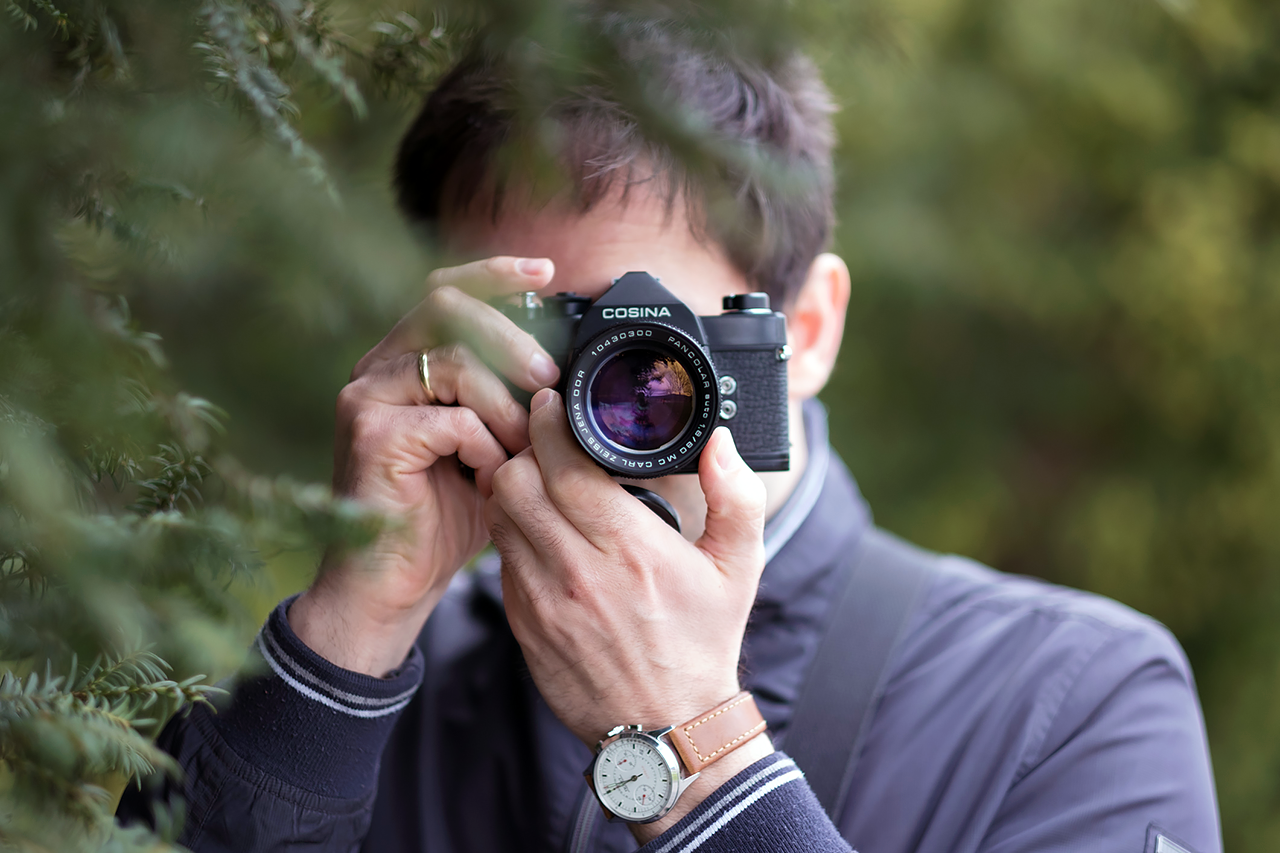

126 film
cameras
- Cosina Instant Matic N-284
(the company’s first complete camera)
35mm film
SLR K mount
- Cosina C1
- Cosina C1s
- Cosina C2
- Cosina C3
- Cosina CS-1 (1978)
- Cosina CS-2
- Cosina CS-3
- Cosina CT-1
- Cosina CT-1A
- Cosina CT1G (1982)
- Cosina CT1 Super (1983)
- Cosina CT1EX
- Cosina CT-2
- Cosina CT-3
- Cosina CT-4
- Cosina CT-7 (Computer CT 7)
- Cosina CT-7D
- Cosina CT9 (1986)
- Cosina CT-10
- Cosina CT-20
- Cosina E1 Solar
- Cosina PM-1
35mm film
M42 mount
- Cosina 1000S
- Cosina 4000S
- Cosina CSL
- Cosina CSM
- Cosina CSR (Vivitar XC-2)
- Cosina Hi-Lite
- Cosina Hi-Lite 202
- Cosina Hi-Lite 205
- Cosina Hi-Lite 402
- Cosina Hi-Lite 405
- Cosina Hi-Lite DL
- Cosina Hi-Lite DLR
- Cosina Hi-Lite HDL
- Cosina Hi-Lite EC
- Cosina Hi-Lite EC II
- Cosina Hi-Lite ECL
- Cosina SLR
- Argus/Cosina STL 1000
35mm film
compact camera
- Cosina 35 (rangefinder)
- Cosina 35 Compact E
- Cosina Compact 35 S
- Cosina 35 EE
- Cosina 35 FR
- Cosina AF-35
- Cosina CX-1
- Cosina CX-2
- Cosina CX5
- Cosina CX5f
- Cosina CX7
- Cosina CX70
110 film
cameras
- PF 5000
Cosina lenses
- Cosina-W MC 28mm f/2.8, 49mm filter size
- Cosina MC Macro 100mm, f/3.5, 49mm filer size
- Cosina-T MC 28-70mm f/2.8-4.3, 67mm filter size
- Cosina MC 28-300mm, f/4.0-6.3, 77mm filter size
- Cosina MC Macro 28-70mm, f/4.0, 62mm filter size
- Cosina MC Macro 35-70mm, f/3.5-4.5, 55mm filter size
- Cosina MC Macro 35-135mm, f/3.5-4.5, 58mm filter size
- Cosina MC Macro 35-200mm, f/4.0-5.4, 62mm filter size
- Cosina MC Macro 70-210mm, f/2.8-3.8, 62mm filter size
- Cosina MC Macro 70-210mm, f/4.5-5.6, 52mm filter size
- Cosina MC Macro 75-200mm, f/4.5-5.6, 52mm filter size
- Cosina MC Macro 75-300mm, f/4.5-5.6, 58mm filter size
- Cosina MC Macro 80-200mm, f/4.5-5.6, 52mm filter size
- Cosina MC Macro 100-500mm, f/5.6-8.0
Cosinon lenses
- Cosinon-W MC 24mm f2.8
- Cosinon Auto 28mm f2.8
- Cosinon Auto 35mm f2.8
- Cosinon Auto 50mm f1.7
- Cosinon Auto MC 50mm f1.7
- Cosinon Auto 50mm f1.8 and f1.9
- Cosinon Auto 55mm f1.4
- Cosinon MC 55mm f1.4
- Cosinon Auto MC 135mm f2.8
- Cosinon Auto MC 200mm f3.5
- Cosinon-T MC 200mm f4
- Cosinon-Z MC 28-50mm f3.5-4.5 zoom
- Cosinon-Z MC 35-70mm f/3.5-4.5 zoom
- Cosinon-Z MC 80-200mm f4.5 zoom
- Cosinon MC 55-225mm f3.5-4.5 zoom MACRO 1:2

